- All photo images set to 600 pixels wide and may be downloaded (right click "Save Image As..."). Image resolution and contrast is poor due to original.
PART IX
PICTORIAL SUMMARY
Pictorial Summary
To accommodate persons of Japanese ancestry subject to evacuation, pending their transfer inland, fourteen temporary Assembly Centers, and one Reception Center were constructed in the states of California, Oregon and Washington in the record period of an average of 21 days each. A former Civilian Conservation Corps camp in Arizona was conditioned as an Assembly Center also. Accommodations varied in capacity from 2,500 to 19,000 persons each.The one Reception Center, at Manzanar, Inyo County, California, was subsequently transferred to the War Relocation Authority, a civilian agency, and became one of ten Relocation Centers. The United States Army Engineers were responsible for the building of all Assembly Centers under the supervision of the Commanding General, Western Defense Command.
Construction of the temporary Assembly Centers was necessary because of the need for speedy evacuation. This could not await the site selection for and construction of the Relocation Centers.
In some cases existing buildings at fair grounds and race tracks utilized for the Assembly Centers were renovated and converted into lodgings, but generally the quarters were newly erected. Each building usually contained four apartments.
In addition, there were constructed or put into condition a variety of other facilities, services and buildings such as administration headquarters, mess halls, hospital units, laundries, washrooms, center stores or canteens, work shops, recreational, educational and religious centers. Fields were improved for outdoor recreational activities.
The series of selected photographs on the following pages, assembled from a number of sources, show phases of the evacuation program.
Figures 142 to 149, inclusive, show construction activity and completed facilities in Relocation Centers. The construction, equipment and initial supply of Relocation Centers was a function of Western Defense Command. The United States Army Engineers also were responsible to the Commanding General for the construction of Relocation Centers.
SOURCE OF SELECTED PHOTOGRAPHS
The following listings, identifying each photo by the "Figure No." preceding it in the following pages, shows the source from which gathered.| OFFICIAL UNITED STATES GOVERNMENT PHOTOS | ||
| United States Signal Corps -- 2, 3, 5, 6, | United States Army Engineers -- 142, | |
| 7, 8, 9, 10, 11, 12, 13, 18, 20, 22, 23, 24, 25, | 143, 144, 146, 147, 148. | |
| 26, 27, 28, 29, 30, 31, 36, 37, 38, 39, 43, 45, | Wartime Civil Control Administration, | |
| 46, 48, 49, 51, 52, 53, 54, 55, 56, 57, 58, 61, | Santa Anita, California, Assembly Center -- | |
| 62, 63, 64, 66, 67, 69, 70, 71, 72, 78, 79, 80, | 19, 21, 32, 33, 42, 44, 47, 50, 59, 60, 65, 68, | |
| 84, 85, 86, 88, 90, 91, 95, 97, 98, 100, 101, | 75, 76, 77, 81, 83, 89, 92, 93, 94, 96, 99, 102, | |
| 104, 107, 108, 109, 110, 112, 113, 114, 115, | 103, 105, 106, 111, 132, 139, 140. | |
| 116, 117, 118, 119, 120, 121, 122, 123, 124, | War Relocation Authority -- 145, 149. | |
| 125, 126, 127, 128, 129, 130, 131, 133, 137, | ||
| 138. | ||
| NEWSPAPER
AND PICTURE SERVICE PHOTOS Courtesy of paper or service indicated. | ||
| Acme
Newspictures, Inc. -- 1, 74, 82. Long Beach, Calif., Press-Telegram -- 15. Los Angeles, Calif., Daily News -- 134, 135, 136. Los Angeles, Calif., Times -- 4, 1 6. Oakland, Calif., Post-Enquirer -- 17. | Portland, Oregon,
Oregonian -- 141. Portland, Oregon, Oregon Journal -- 35, 40, 41, 87. Sacramento, Calif., Union -- 34. San Francisco, Calif., News -- 73. Tacoma, Wash., News-Tribune -- 14. | |
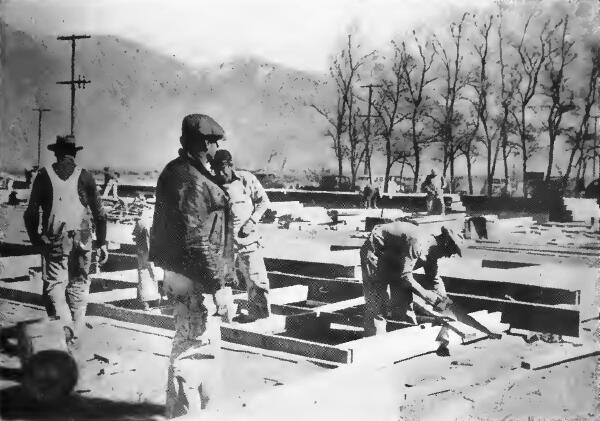 FIGURE 1: An early construction scene at Manzanar Reception Center, in Owens Valley, Inyo County, California. This was the first of a series of Centers constructed by the Army, and later became a Relocation Center under the War Relocation Authority. 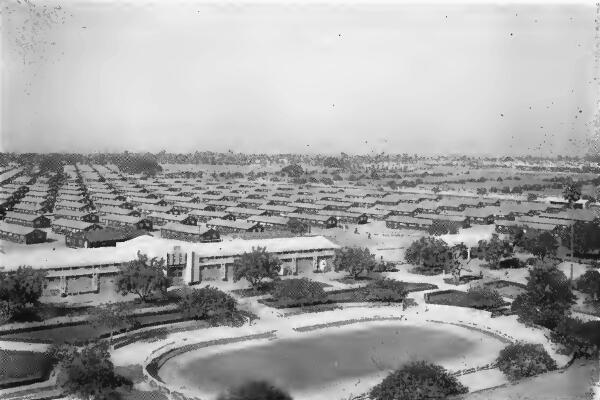 FIGURE
2: A portion of the completed Santa Anita (California) Assembly Center,
situated within the world famous race track at Arcadia, California. This was the largest of all Assembly Centers. Nearly 19,000 persons were lodged here. 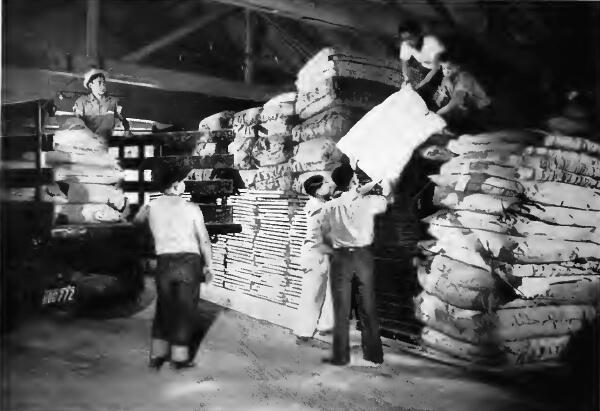 FIGURE 3: Members of an advance party of evacuees loading bedding and other equipment in warehouse at Pomona (California) Assembly Center. Centers were readied for evacuee reception in advance. 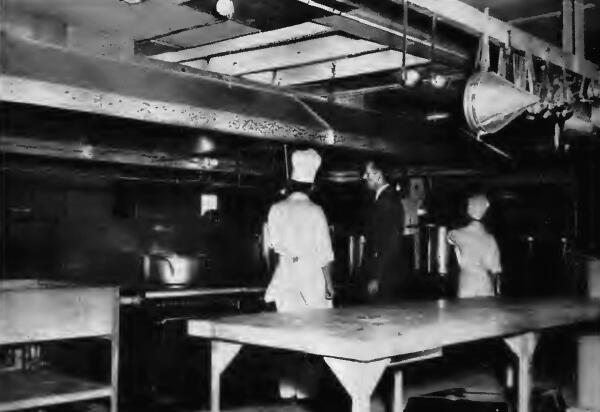 FIGURE 4: Scene in the first kitchen to be opened at the Santa Anita (California) Assembly Center. Modern kitchen and cooking equipment were supplied the mess halls at all centers. 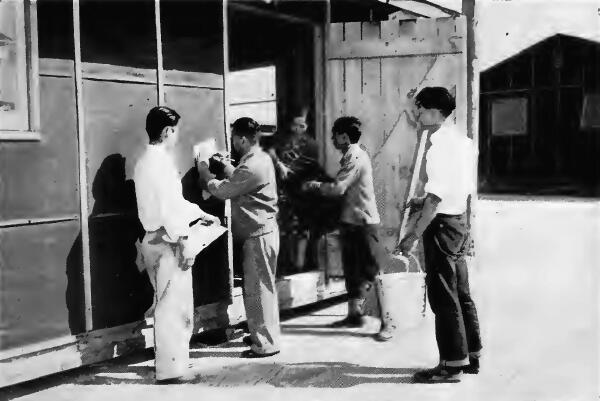 FIGURE 5: Delivering issues of bedding and household utensils to apartment of a newly arrived evacuee family. 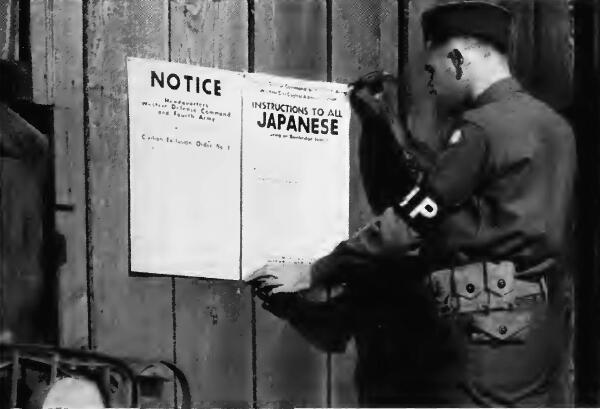 FIGURE 6: Military Police posting Civilian Exclusion Order No. 1, requiring evacuation of Japanese living on Bainbridge Island, in Puget Sound, Washington. Civilian Exclusion Orders, numbered 1 to 108, were issued by the Commanding General ordering exclusion of persons of Japanese ancestry from 108 specific areas in the states of California, Oregon, Washington, and Arizona. 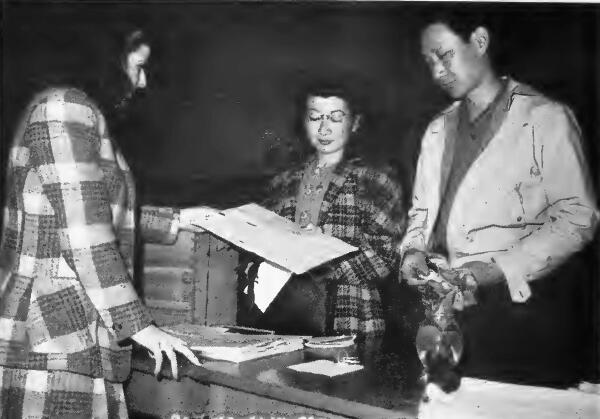 FIGURE 7: Young Japanese couple receive their registration record as first step in the evacuation of San Francisco. The same system and forms were used in registration in all evacuation operations. 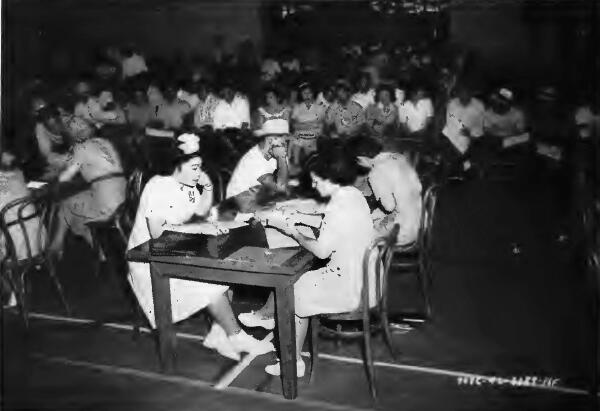 FIGURE 8: Group of registrants in Civil Control Station at Sanger, California. After receiving registration forms, evacuees were interviewed by civilian clerks, who aided them in filling out the necessary blanks.  FIGURE 9: Registrants being interviewed by the Public Assistance Department of the Control Station at Visalia, California. Those who registered were given opportunity to arrange their affairs. They then returned to the Control Station, where they were again interviewed to ascertain if they needed assistance to evacuate. 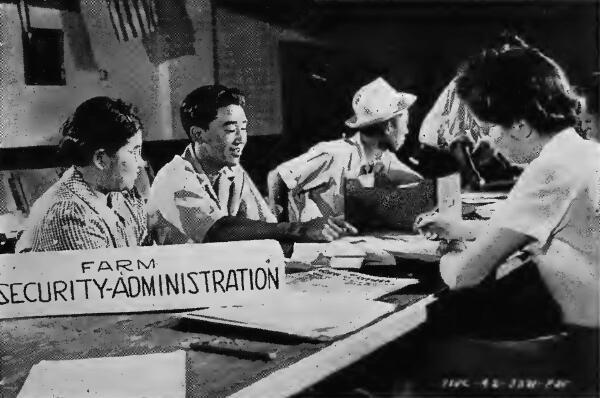 FIGURE 10: Group being interviewed by Farm Security Administration representatives. Arrangements were made to assist evacuees in the equitable disposition of their agricultural interests and properties. 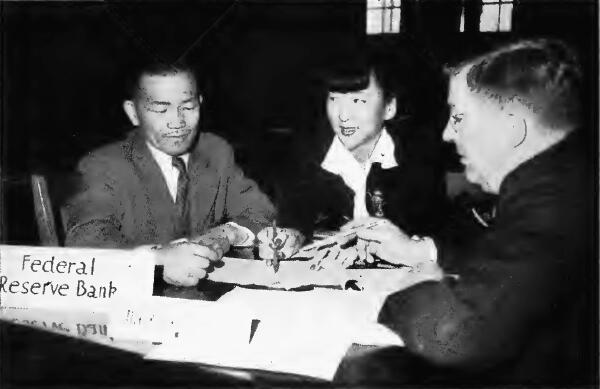 FIGURE 11: Japanese being interviewed by a representative of the Federal Reserve Bank at a San Francisco Control Station, assisted by a young Japanese of American birth as interpreter and clerk. The Federal Reserve Bank of San Francisco had representatives at all Control Stations to aid or advise evacuees as to storage or equitable disposition of their personal and business properties. 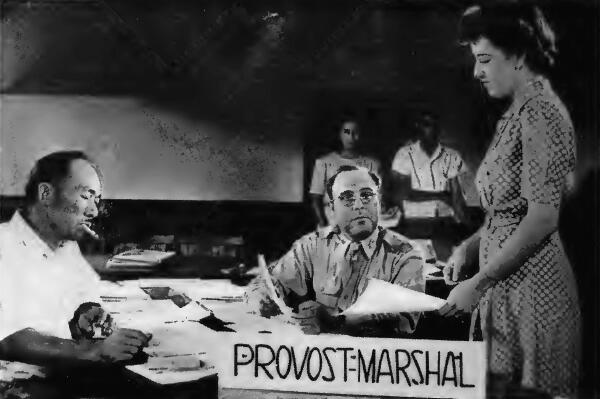 FIGURE 12: Scene at an assistant Provost Marshal's desk in the Visalia, California, Control Station, July 28, 1942. Representatives of the Provost Marshal's office were assigned to all of the Control Stations to instruct evacuees as to time and place of departure for the Assembly Centers and to pass an application for deferment. 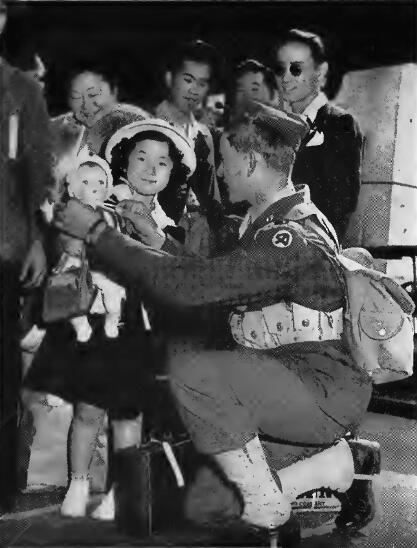 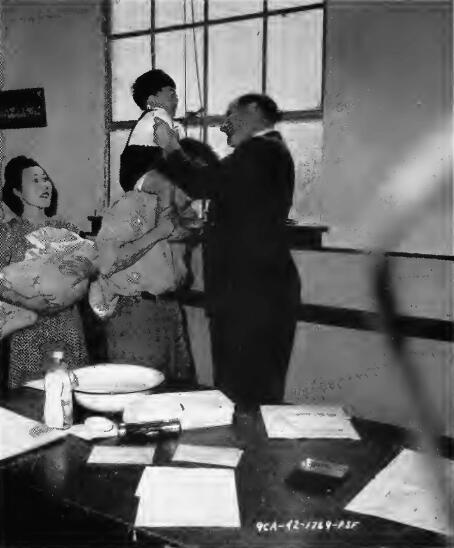 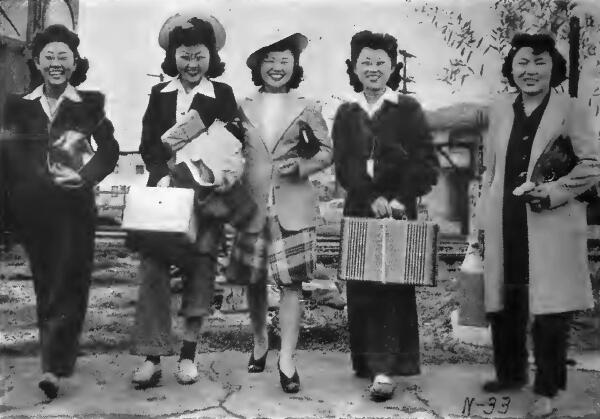 FIGURE 15: Group of young Japanese girls arriving at a Long Beach, California railroad station to board a special electric train for the Santa Anita Assembly Center, April 4, 1942. 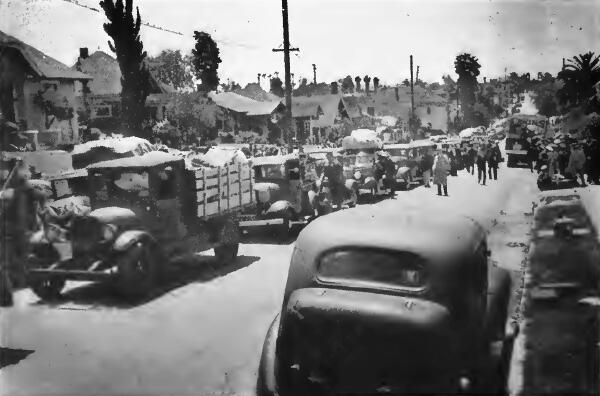 FIGURE 16: Caravan of trucks loaded with baggage and private cars ready to leave a Control Station in Los Angeles, April 28, 1942 for Manzanar Reception Center. Departure from the various areas was at first by private automobile, with trucks for baggage. Later only by train or bus. Large moving vans were available to handle household or other goods the evacuees desired to have stored under supervision of the Federal Reserve Bank. 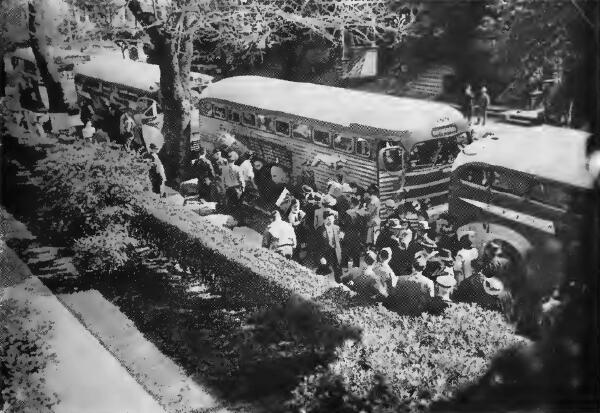 FIGURE 17: Evacuees loading baggage and boarding special buses at a Berkeley Control Station April 30, 1942. Evacuees from the San Francisco (California) Bay Area were transported from the Control Stations to Tanforan Assembly Center. 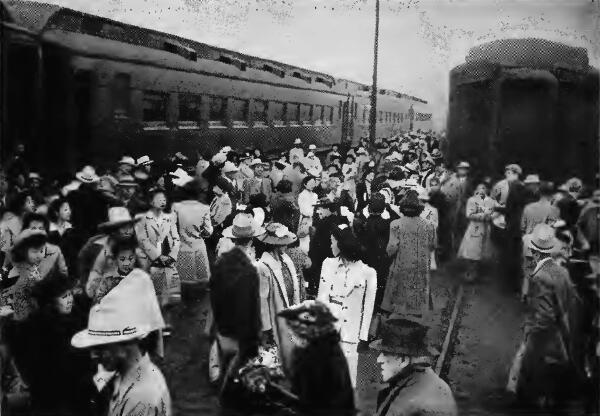 FIGURE 18: Group of evacuees assembled at a Los Angeles railroad station waiting to board train for Santa Anita Assembly Center. Other evacuees were transported from their residence areas to Assembly Centers by train. 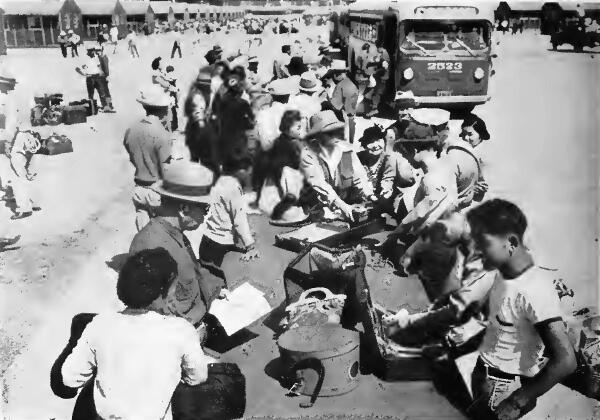 FIGURE 19: Group of evacuees after arriving by bus at Santa Anita (California) Assembly Center and undergoing baggage inspection. Upon arrival at Assembly Centers the baggage of evacuees was inspected by the Interior Security Police and articles of contraband removed and receipts issued for this and other articles not needed for storage in warehouses. 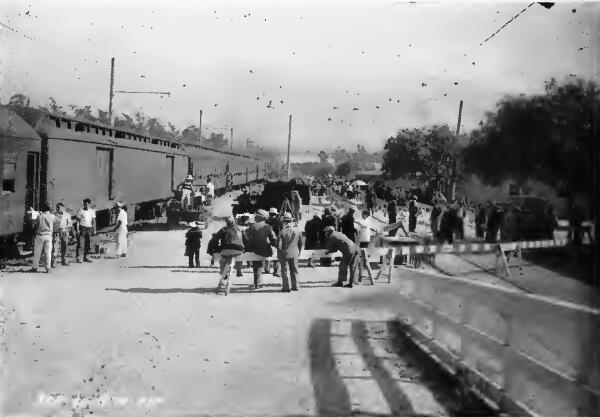 FIGURE 20: A trainload of evacuees arrive by train at Santa Anita (California) Assembly Center and disembark for registration within the Center and assignment to quarters. 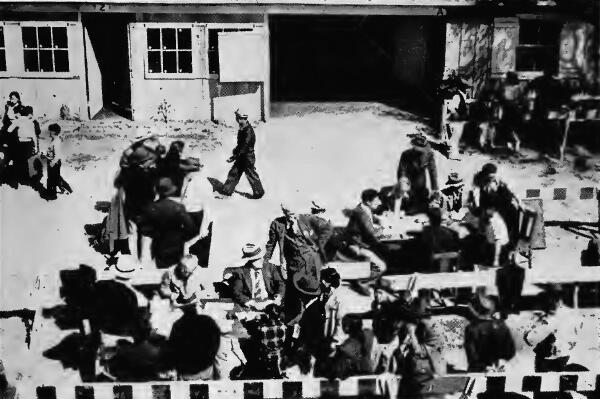 FIGURE 21: Registration and processing scene at Santa Anita (California) Assembly Center. On arrival at Assembly Centers, the evacuees were directed to registrars, who had the individual and family files before them, registered in and assigned to quarters; given identification buttons and escorted to quarters. 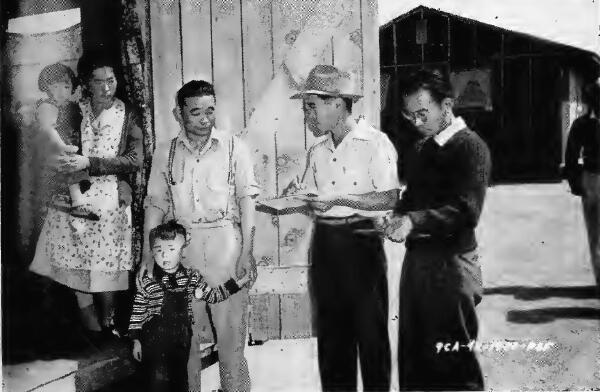 FIGURE 22: Head of a family of four being interviewed after arrival at Santa Anita (California) Assembly Center. After assignment to quarters, the head of each family was interviewed by members of the administrative staff, usually Japanese, as to experience, ability and willingness to work. 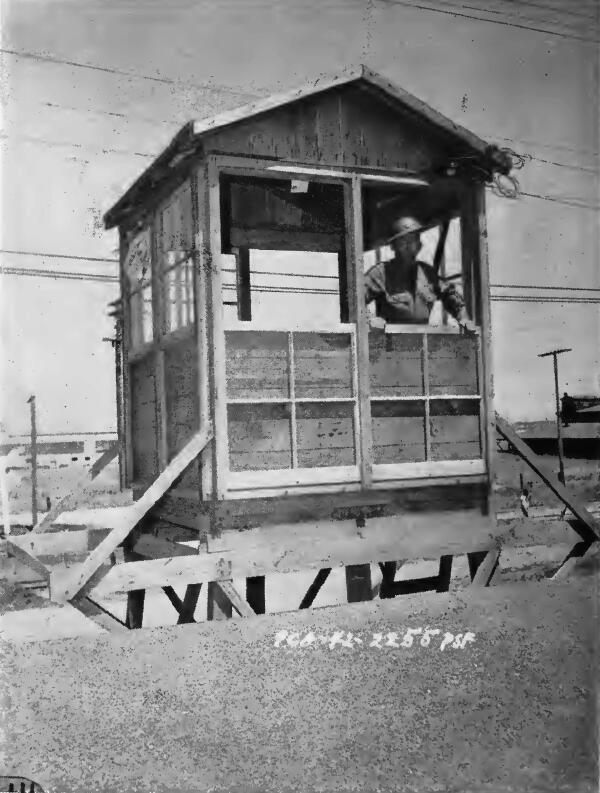 FIGURE 23: Guard on duty in watch tower at Tanforan (California) Assembly Center. The Military Police were responsible for the external security of the Assembly Centers. In addition to details of Military Police assigned to the external boundaries of the Centers, guard towers were erected at strategic points and a watch kept for fires or other dangers. 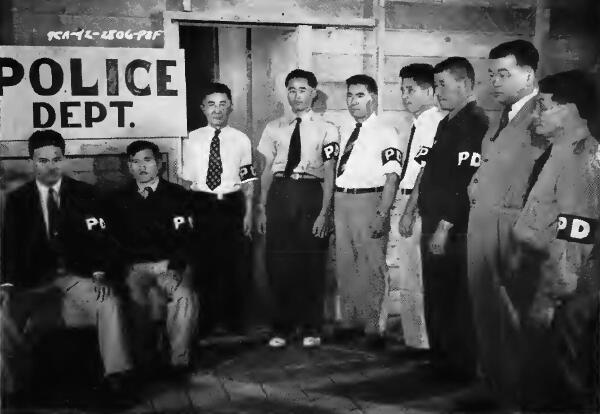 FIGURE 24: Japanese police unit at Portland (Oregon) Assembly Center. Under Caucasian supervision, internal police units of evacuees were organized in the Assembly Centers. 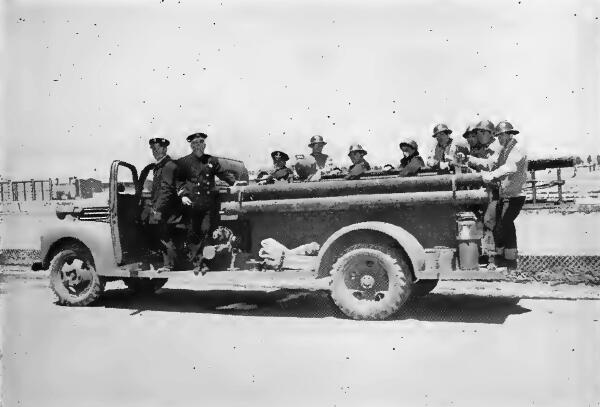 FIGURE 25: Unit of the Tanforan (California) Assembly Center Fire Department, manned by two Caucasian firemen and a group of evacuees who were given training in fire prevention. Modern fire fighting equipment was supplied to all Assembly Centers, in many cases from the nearest town or city, and operated under the direction of experienced firemen. 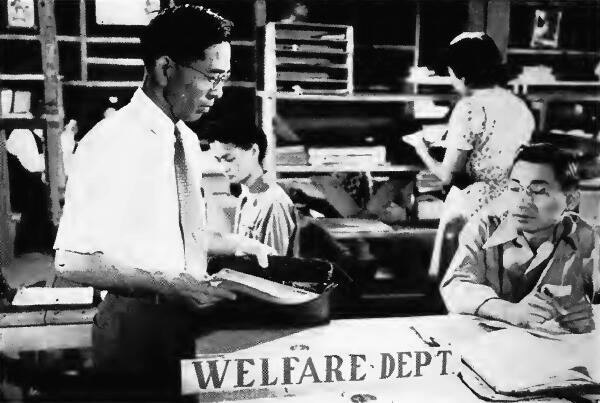 FIGURE 26: Administrative staffs under the Caucasian Center Manager were established at all Centers to supervise all Center operations and activities. Evacuee personnel were enlisted and paid to assist in administration as well as all other Center work. Scene in an Assembly Center Welfare Office. 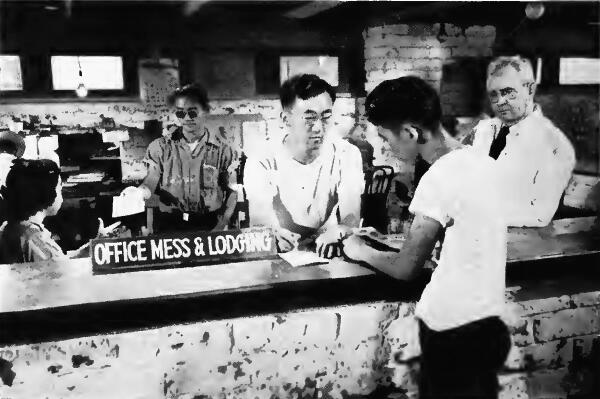 FIGURE 27: Mess and lodging office at Pomona (California) Assembly Center. Another phase of administration was the mess and lodging staff composed of evacuees under the direction of a Caucasian manager. This unit handled the assignment of Japanese employees to mess and lodging employment. 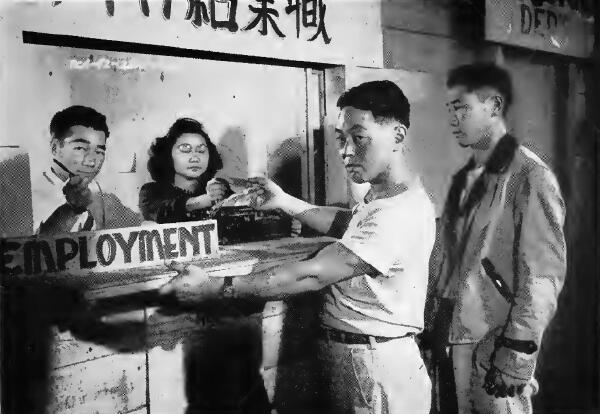 FIGURE 28: Employment office at the Portland (Oregon) Assembly Center. Employment offices, through which evacuees desiring to work were given suitable assignments, were established in all the Centers. 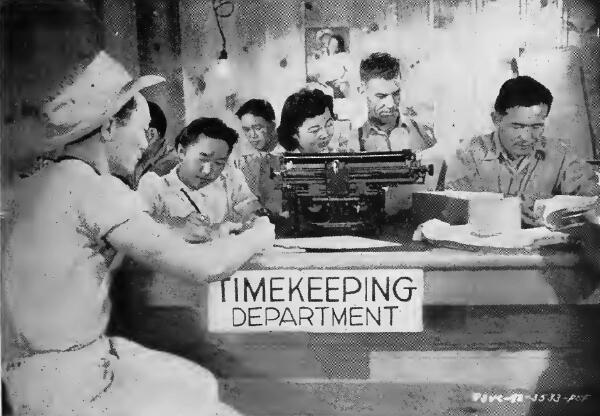 FIGURE 29: Scene in the timekeeping office at Stockton (California) Assembly Center. 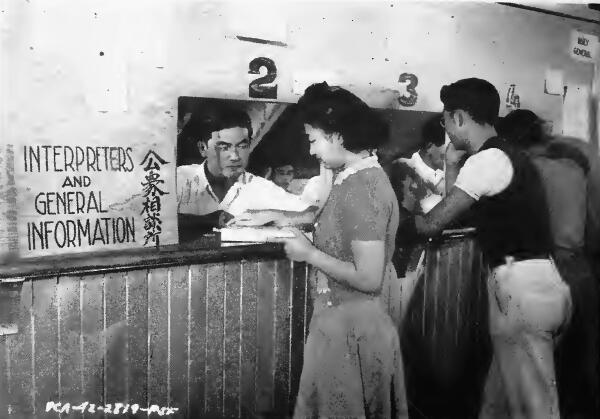 FIGURE 30: The information section at Portland (Oregon) Assembly Center. An important phase of the administrative facilities at each Assembly Center was the information unit. 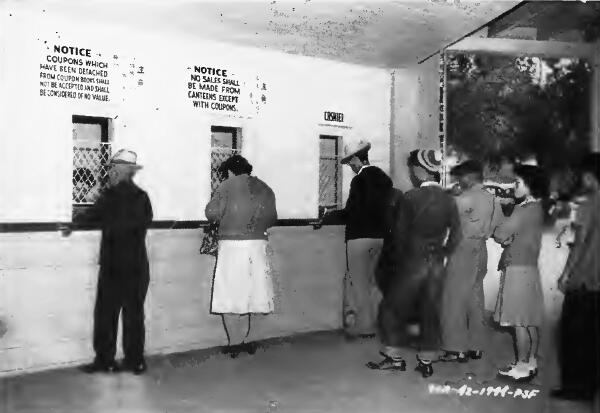 FIGURE 31: Evacuees drawing coupon books at Assembly Center. In addition to the nominal wages paid, if employed within the Centers, evacuees were entitled without cost to coupon or script books, redeemable at Center stores or canteens for personal items. 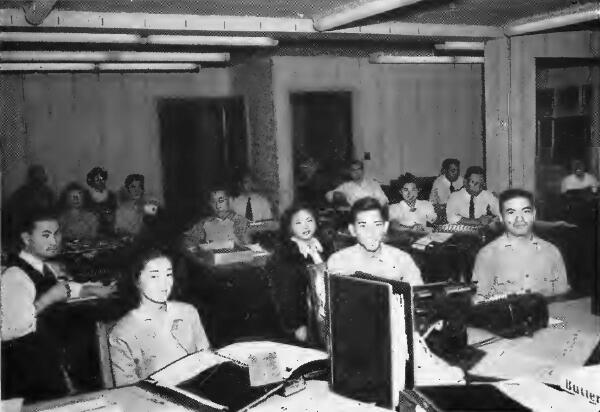 FIGURE 32. Finance division at Santa Anita (California) Assembly Center. Evacuees staffed the finance divisions at all the Centers, where employment and other fiscal records were kept.  FIGURE 33: Group of evacuee representatives of the Santa Anita (California) Assembly Center at a regular meeting. Evacuees in the Assembly Centers expressed their opinion and recommendations on internal problems through a center council, which worked in an advisory capacity with the administrative staff. 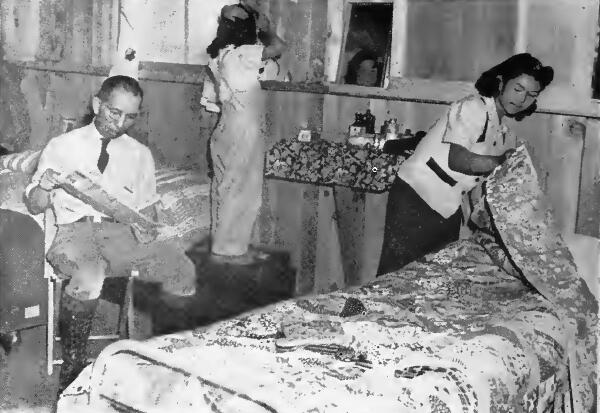 FIGURE 34: Family group in an apartment at Sacramento (California) Assembly Center. 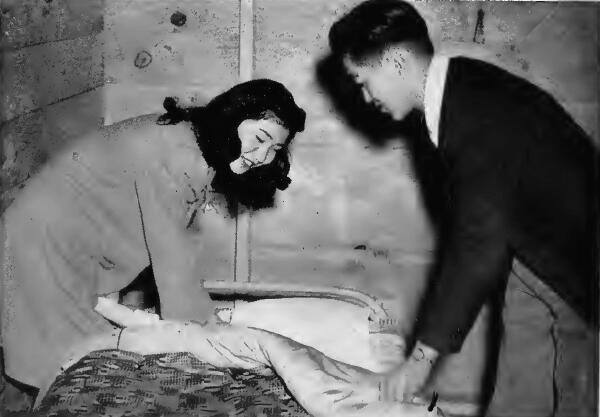 FIGURE 35: Brother and sister preparing quarters at Portland (Oregon) Assembly Center. 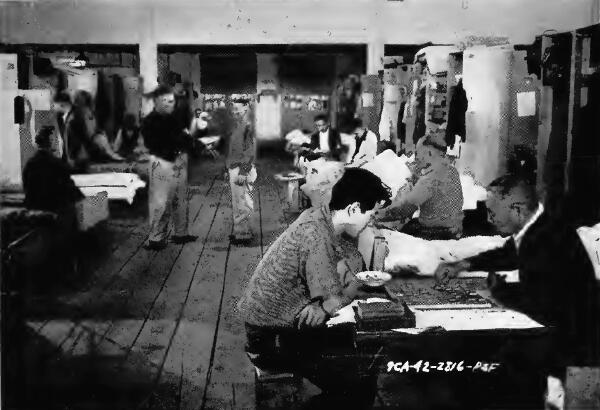 FIGURE 36: A single men's dormitory at Portland (Oregon) Assembly Center. 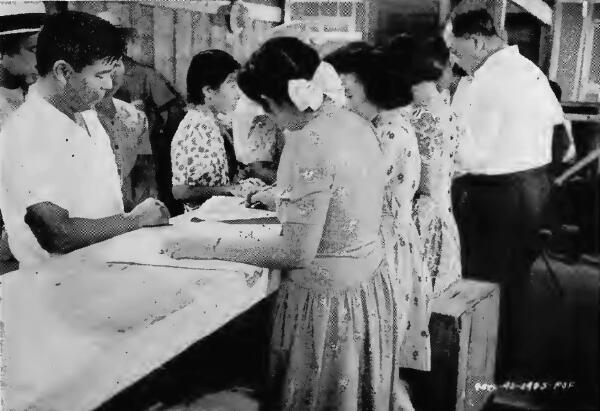 FIGURE 37: Evacuees signing up for clothing issue at Fresno (California) Assembly Center. Clothing allowances for necessary apparel for evacuees were authorized, upon application.  FIGURE 38: An evacuee checker inspecting fresh vegetables at Fresno (California) Assembly Center. 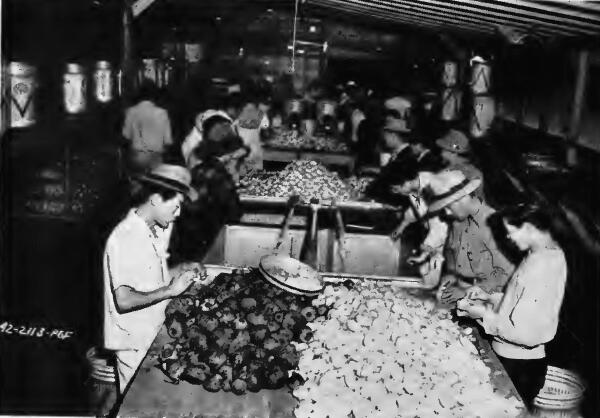 FIGURE 39: Evacuee workers at the Santa Anita (California) Assembly Center preparing vegetables for cooking. Assorted vegetables were supplied for standard and special diets for the evacuees, and prepared for table by the evacuee culinary staffs. 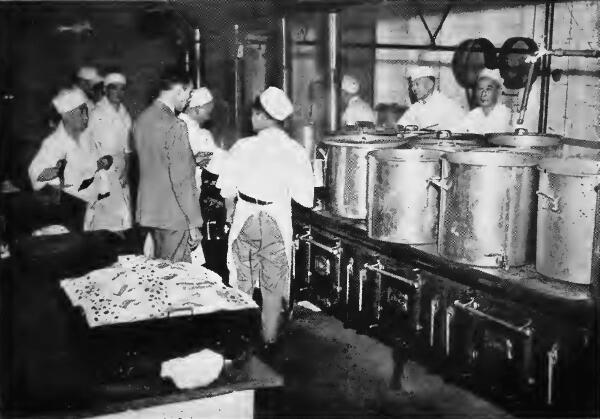 FIGURE 40: A kitchen scene at Portland (Oregon) Assembly Center. In all Assembly Centers food for the evacuees was prepared in modern kitchens by Japanese culinary staffs, operating under Caucasian supervision. 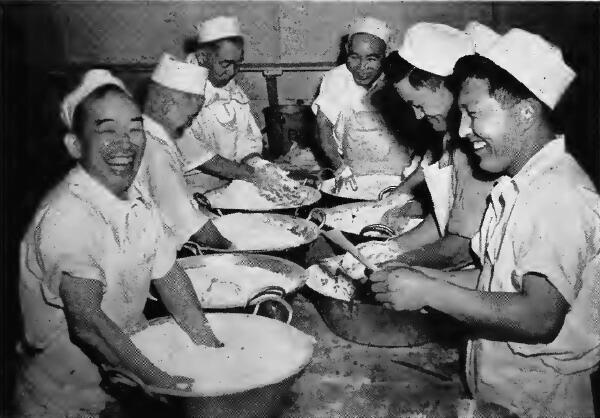 FIGURE 41: A group of evacuee bakers at the Portland (Oregon) Assembly Center preparing a batch of apple cobbler. 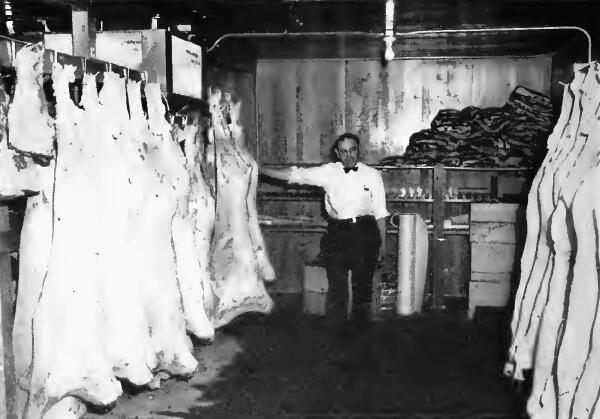 FIGURE 42: A scene in the meat storage room at Santa Anita (California) Assembly Center. Evacuees received a balanced ration, which included fresh meat, vegetables and fruits. Refrigeration facilities were provided at all Centers. 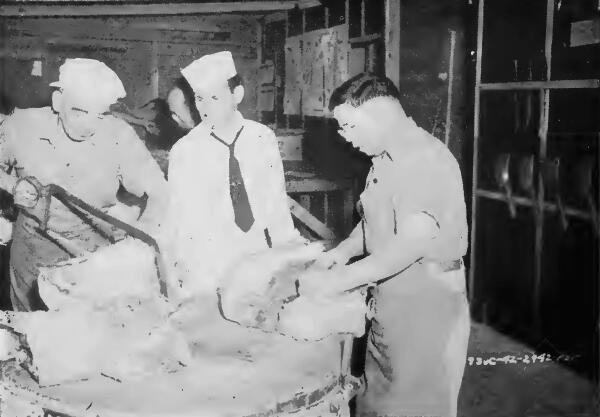 FIGURE 43: Evacuee meat cutters at work at Turlock (California) Assembly Center. Experienced evacuee butchers were employed in the meat cutting departments at the Centers, under supervision of Caucasian cooks. 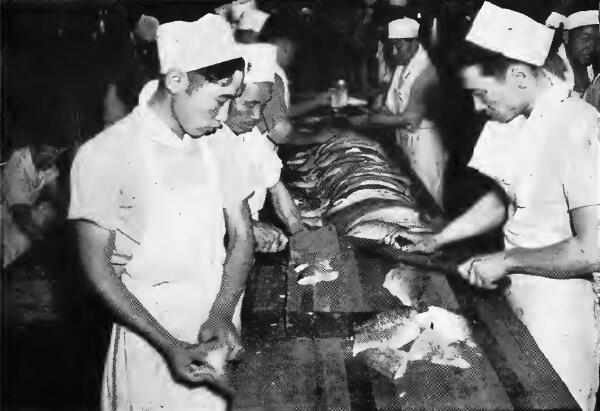 FIGURE 44: Japanese fish butchers at the Santa Anita (California) Assembly Center. Fresh fish in season was supplied for the evacuees where available. 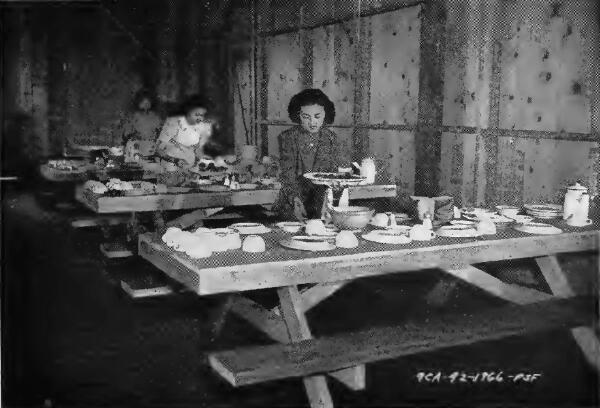 FIGURE 45: Evacuee waitresses setting tables in a mess hall in one of the assembly centers -- meals were served family style in nearly all centers. 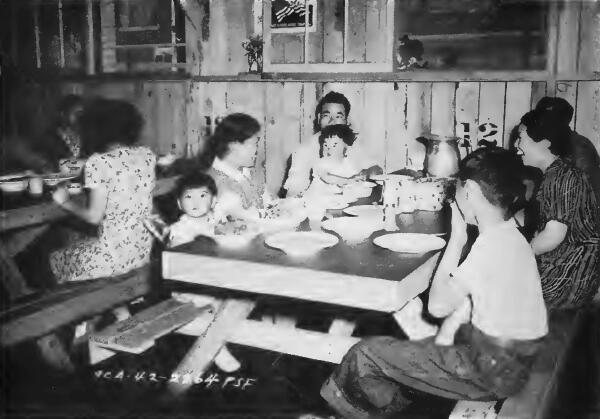 FIGURE 46: A family group at mess at Tanforan (California) Assembly Center. Every effort was made to provide mess facilities for family groups.  FIGURE 47: Sanitation in kitchens and mess halls in all assembly centers was rigidly supervised. A dishwashing unit in operation at Santa Anita (California) Assembly Center. 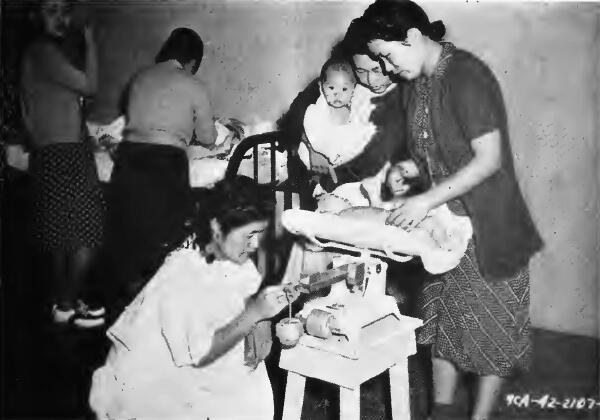 FIGURE 48: An evacuee nurse's aid at Santa Anita (California) Assembly Center, weighing a baby, while mother watches. Modern facilities were provided for the care of infants at the Assembly Center. 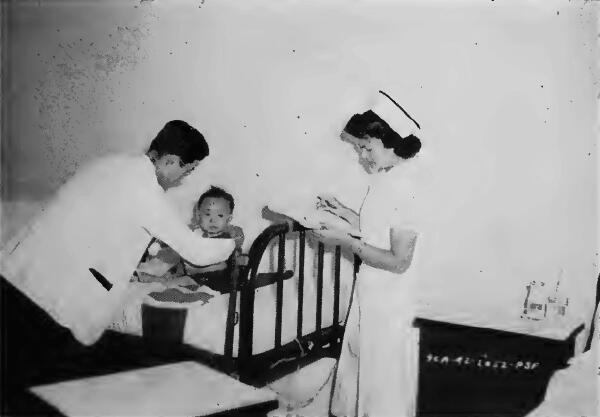 FIGURE 49: An evacuee doctor examining a baby while an evacuee nurse writes the medical record. Experienced physicians and nurses were provided at all Centers to protect the health of infant evacuees. 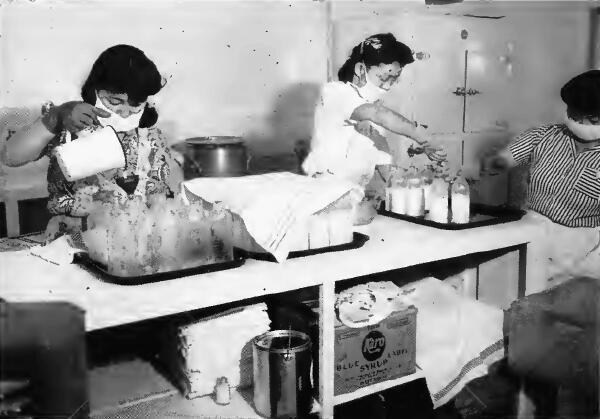 FIGURE 50: An infant formula preparation unit at Santa Anita (California) Assembly Center. Formula kitchens under the direction of the chief medical officers and hospital dieticians prepared the formulaes under the most sanitary conditions, and prepared the bottles for delivery. 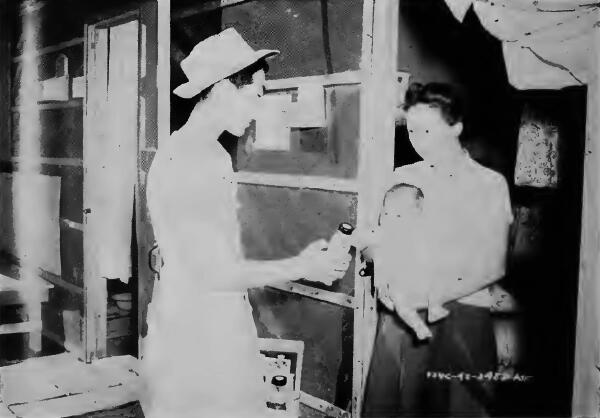 FIGURE 51: An evacuee messenger delivering a bottle of baby formula to a mother at Fresno (California) Assembly Center. Baby formulaes were delivered direct to the apartments of the infants by messengers, or obtained at convenient milk station. 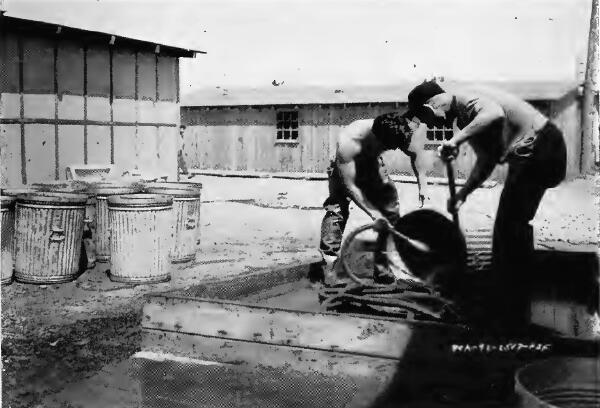 FIGURE 52: Evacuee workers giving garbage cans a daily washing, at Puyallup (Washington) Assembly Center. 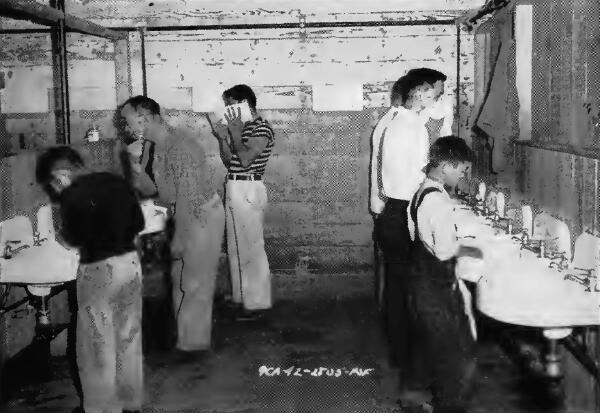 FIGURE 53: A wash room scene at Portland (Oregon) Assembly Center. Modern wash rooms, with hot and cold running water, were provided in all of the Centers. 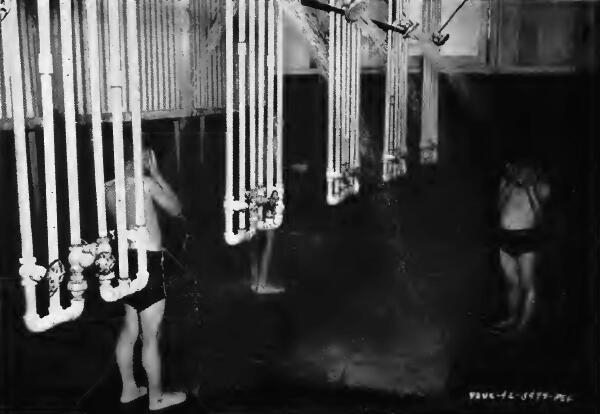 FIGURE 54: A shower room scene at Fresno (California) Assembly Center. Separate shower rooms for men and women were provided in all Centers.  FIGURE 55: First-aid treatment for superficial cuts and bruises being administered at the Santa Anita (California) Assembly Center. Modern first-aid stations were provided at all the Centers. 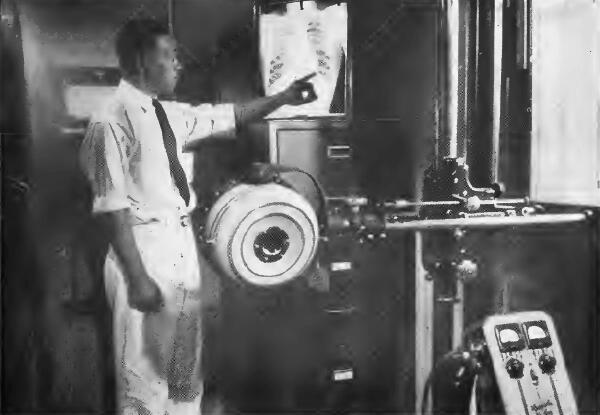 FIGURE 56: A technician in X-Ray laboratory at Pomona (California) Assembly Center. Hospital equipment at the centers included X-Ray machines. 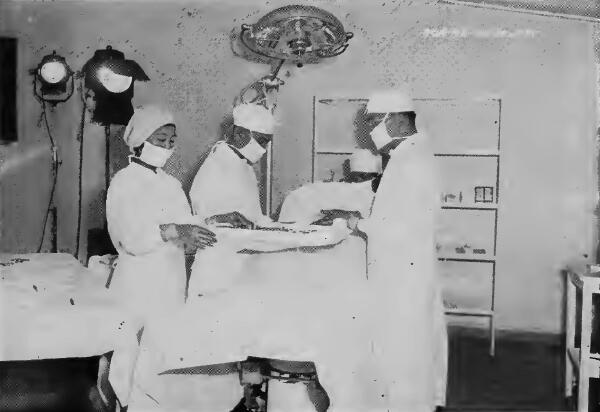 FIGURE 57: A mock operation scene at Santa Anita (California) Assembly Center. Skilled surgeons and experienced surgical nurses were among the evacuees at nearly all of the Centers. 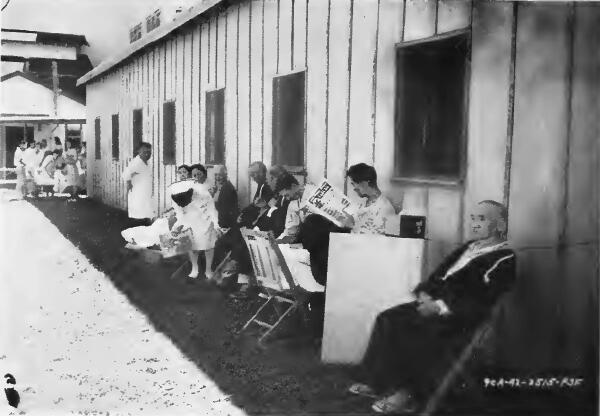 FIGURE 58: Attended by evacuee nurses and orderlies, convalescing patients rest in the shade on the lawn behind the center hospital at Puyallup (Washington) Assembly Center. 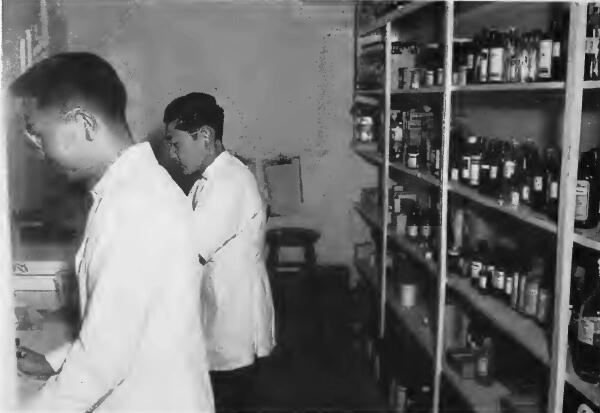 FIGURE 59: Hospital pharmacy at Santa Anita (California) Assembly Center. A complete line of essential drugs and medical supplies were available at all Assembly Center pharmacies.  FIGURE 60: Two evacuee laboratory technicians at work at Santa Anita (California) Assembly Center. Hospital facilities at all centers included adequately equipped laboratories. 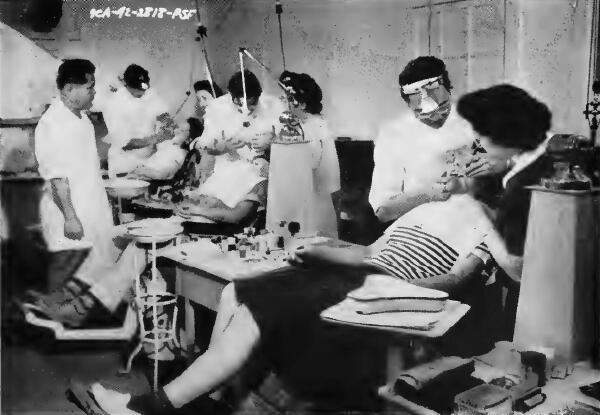 FIGURE 61: Dental clinic in operation at Portland (Oregon) Assembly Center. Many dentists were among the evacuees and they conducted clinics under Caucasian supervision, to provide essential dental care.  FIGURE 62: Laundry room at Portland (Oregon) Assembly Center. Laundry facilities conveniently located, were provided in all Centers. 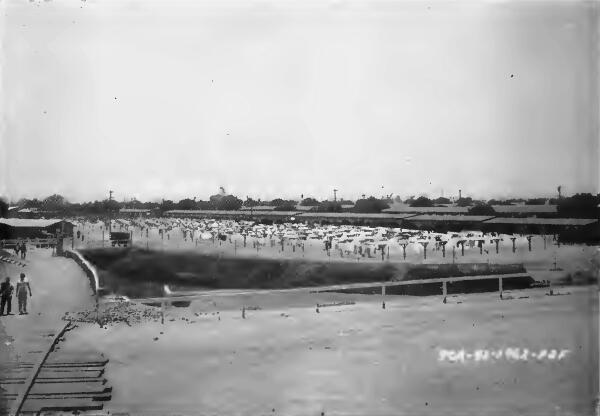 FIGURE 63: One of several laundry drying yards at Santa Anita (California) Assembly Center. 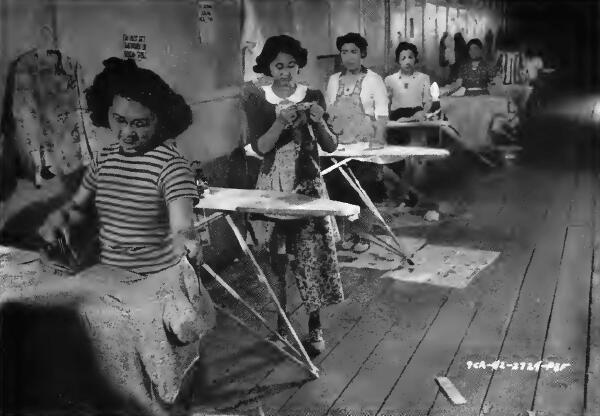 FIGURE 64: An ironing room at Portland (Oregon) Assembly Center. Facilities for ironing clothes, including sockets for electric irons, were provided at all the Centers.  FIGURE 65: One of two 12-chair barber shops at Santa Anita (California) Assembly Center. Barber shops were operated in all the Centers. 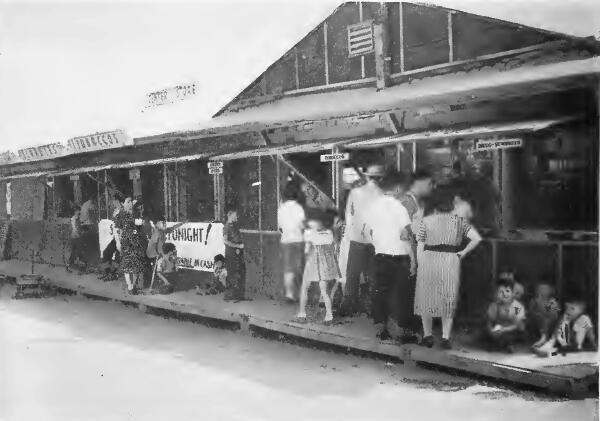 FIGURE 66: One of the Pomona (California) Assembly Center stores with various sections selling cookies, cakes, pies and fruit, tobaccos, drugs and sundries. Center stores, or canteens were operated in all Assembly Centers and carried a wide variety of articles which the evacuees could purchase with coupons issued each month.  FIGURE 67: A display of an assortment of candy bars at Portland (Oregon) Assembly Center. 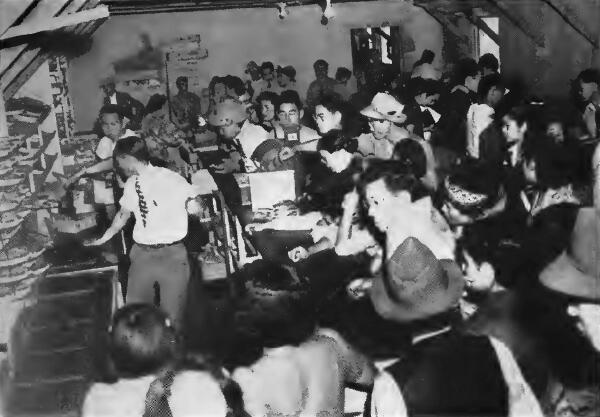 FIGURE 68: A busy hour in one of the three canteens at Santa Anita (California) Assembly Center. 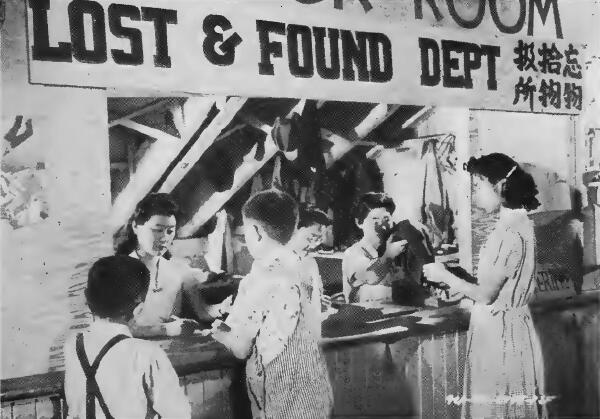 FIGURE 69: The lost and found department at Portland (Oregon) Assembly Center. This department was found in each Center. 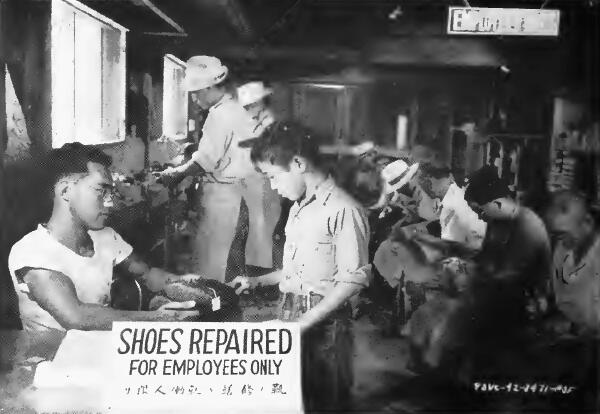 FIGURE 70: A shoe repair shop at Stockton (California) Assembly Center. Experienced evacuee shoemakers operated repair shops in some Centers for employees only. 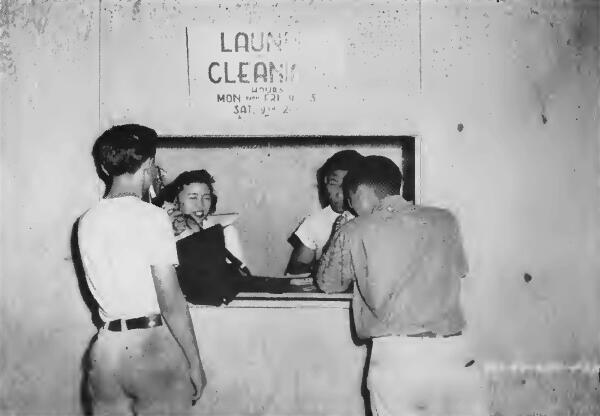 FIGURE 71: The laundry and dry cleaning office at Portland (Oregon) Assembly Center. These facilities were available to evacuees at all Centers through service offices manned by evacuees. 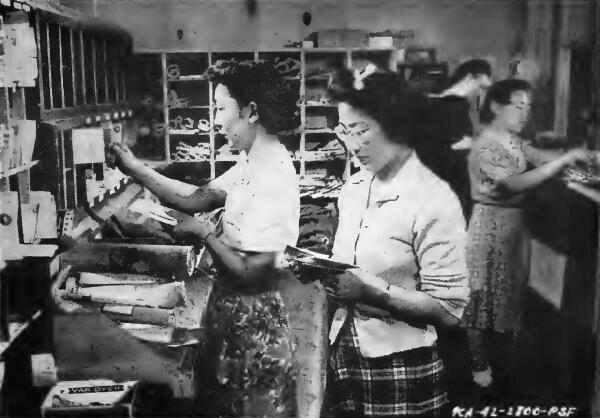 FIGURE 72: The post office at Portland (Oregon) Assembly Center. Complete postal service, under jurisdiction of the nearest U. S. Post Office, was provided at all Centers and included regular mail delivery, general delivery, parcel post, money order, and other units. 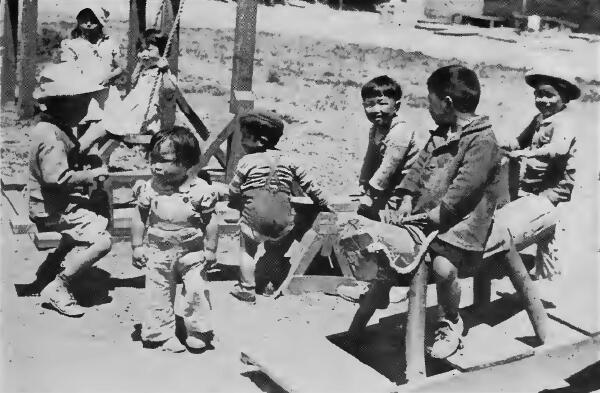 FIGURE 73: A play scene at Tanforan (California) Assembly Center, with home-made rocking horses, teeter-totters, and swings. Playfields with rustic equipment made of scrap material and other installations stimulated recreational and outdoor play activities which many young evacuees had never before enjoyed. 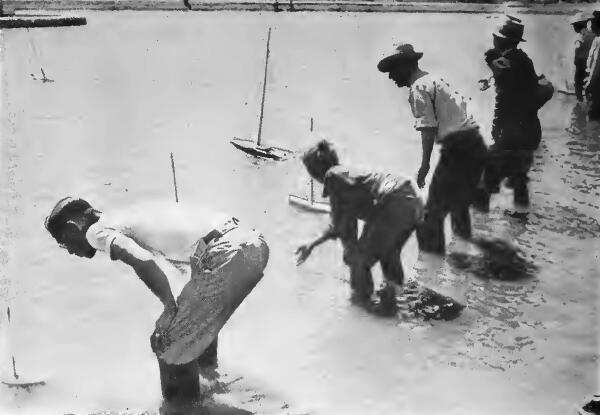 FIGURE 74: Adults and children sailing model yachts in a contest during a Mardi Gras celebration at Tanforan (California) Assembly Center. A variety of recreational activities were conducted at various Centers. 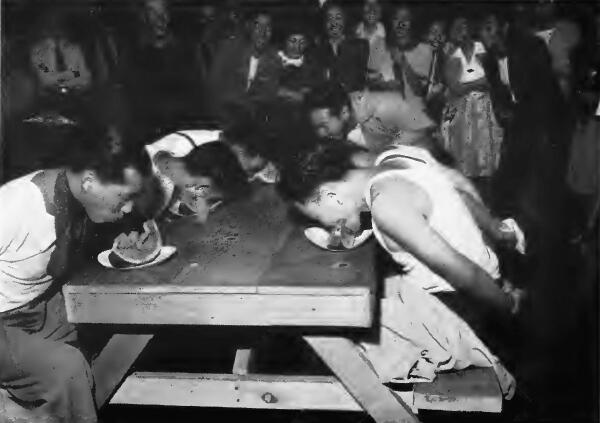 FIGURE 75: Evacuees in a watermelon eating contest at Santa Anita (California) Assembly Center. Special activities sections were established at centers under the Recreation Division and conducted diversified recreational stunts.  FIGURE 76: A baby parade, with humorous touches added by adults posing as infants, was a feature of a three day "Funita" staged at Santa Anita (California) Assembly Center. 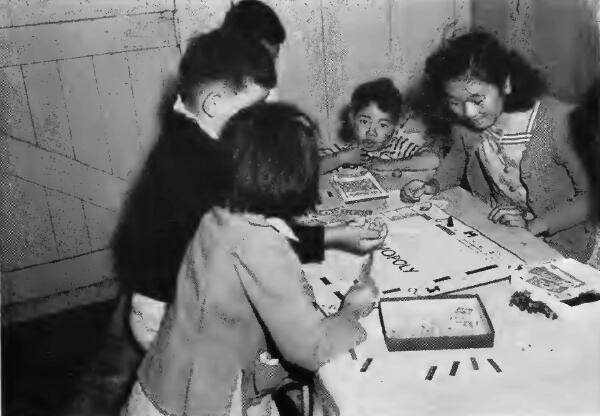 FIGURE 77: A youthful group intensely interested in a game of Monopoly at Santa Anita (California) Assembly Center. 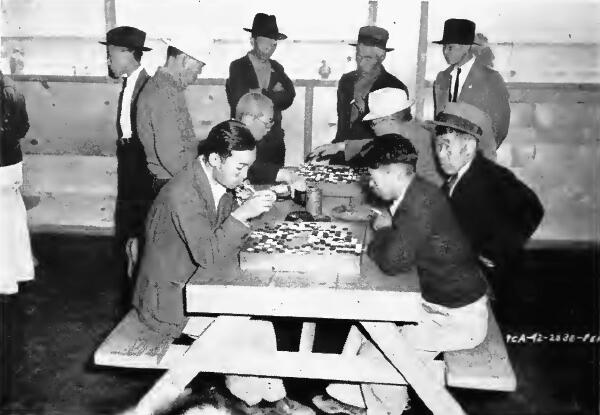 FIGURE 78: "Go," a Japanese type of chess or checkers, being played at Santa Anita (California) Assembly Center. A variety of games were provided as part of the recreational programs. 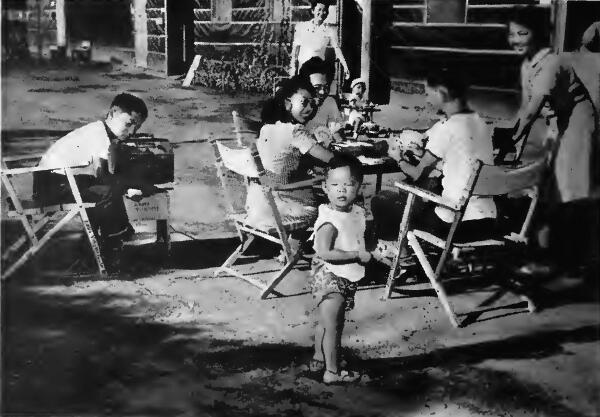 FIGURE 79: A family group enjoy a card game and the radio outside of their quarters at Assembly Center. 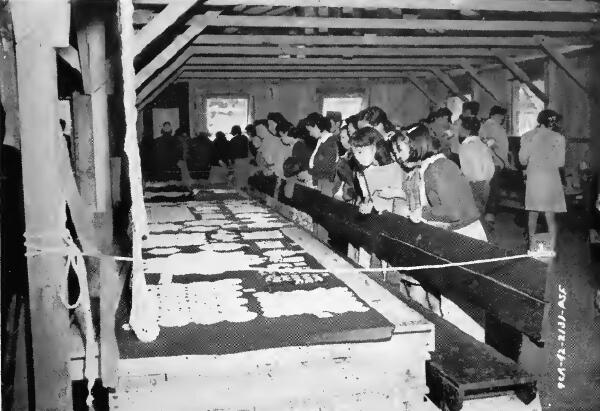 FIGURE 80: A needlework display at Santa Anita (California) Assembly Center. 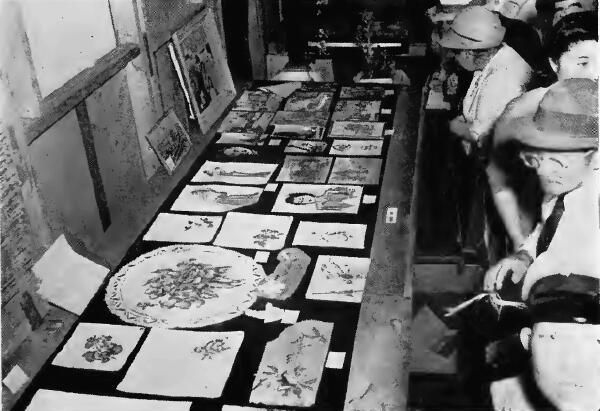 FIGURE 81: A handicraft and hobby show at Santa Anita (California) Assembly Center. 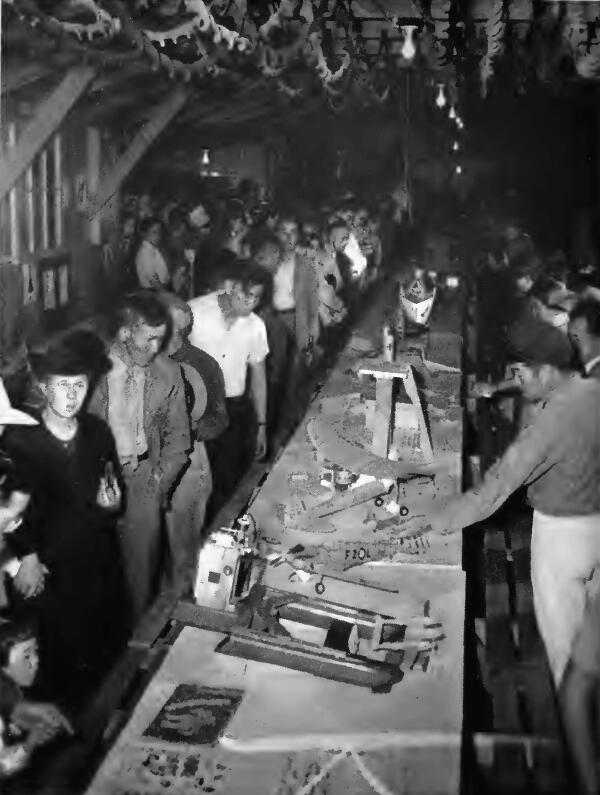 FIGURE 82: A portion of a handicraft and hobby show staged at Tanforan (California) Assembly Center, where everything from juvenile drawings and paintings to model airplanes were shown. 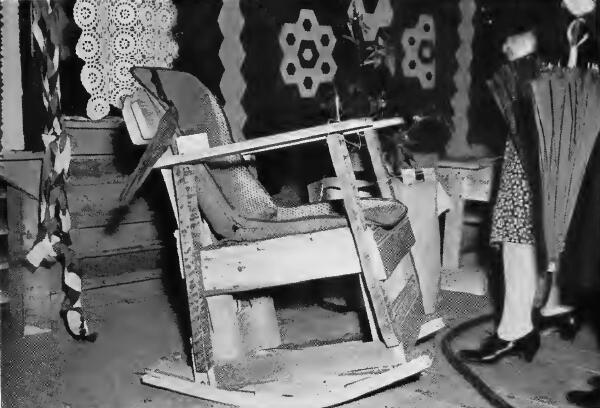 FIGURE 83: A rocking chair made by an evacuee at Santa Anita (California) Assembly Center. Evacuees made many improvised articles of furniture out of scrap material, usually with no more tools than a saw and hammer. 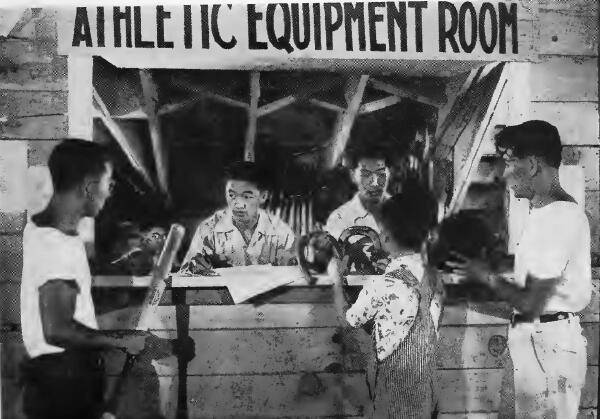 FIGURE 84: Evacuees signing for baseball equipment, horseshoes and volley balls at Portland (Oregon) Assembly Center. Athletic equipment was available to evacuees at all centers for nearly all types of sports. 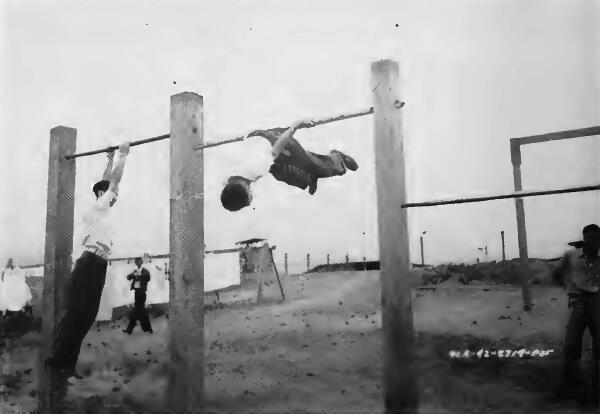 FIGURE 85: Two young evacuees at "skin the cat" on exercise bars at Portland (Oregon) Assembly Center. 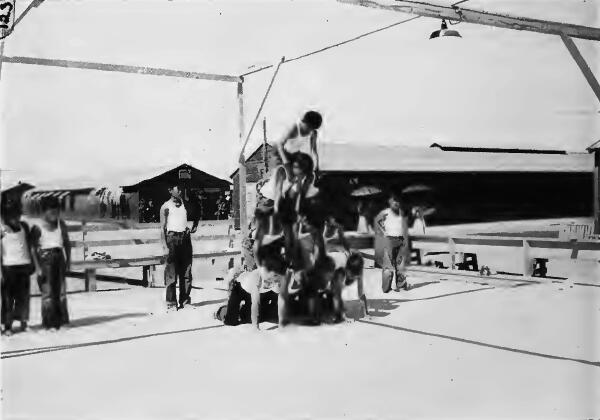 FIGURE 86: A youthful group of "pyramiders" in action at Fresno (California) Assembly Center. Gymnastics was a favorite form of recreation of many of the younger evacuees. 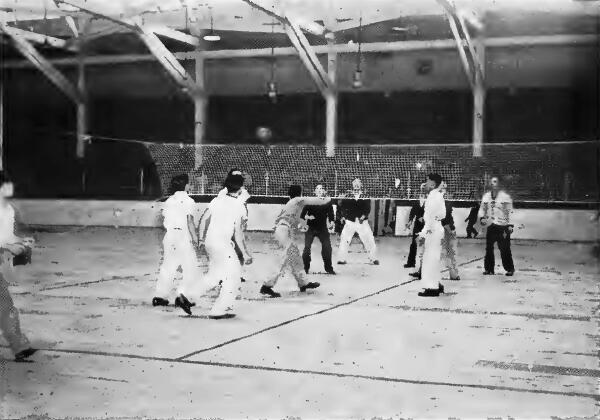 FIGURE 87: A volley ball game at Portland (Oregon) Assembly Center. Baseball, basketball, tennis and badminton facilities were also available at Centers. 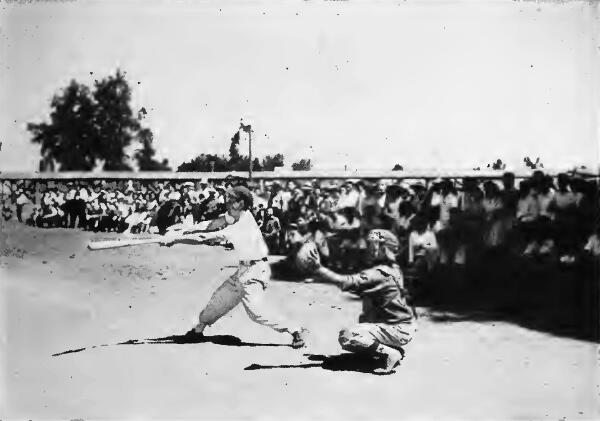 FIGURE 88: Action in a baseball game at Portland (Oregon) Assembly Center. Baseball was a favorite sport at all of the Centers and many teams were organized and played regular league schedules within the Centers. . 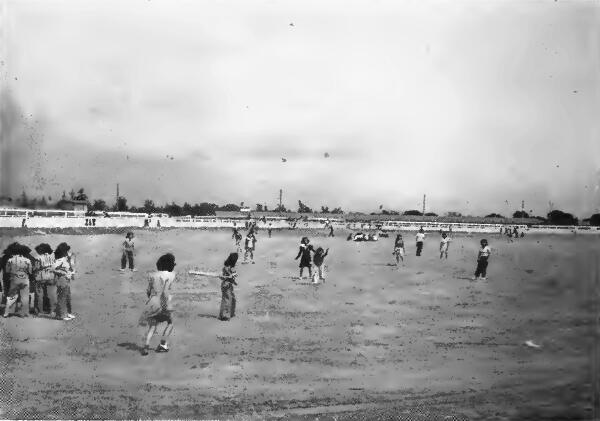 FIGURE 89: Softball games proved popular with the girls at Assembly Centers. Leagues were organized, and re-organized at intervals to permit new players to participate. 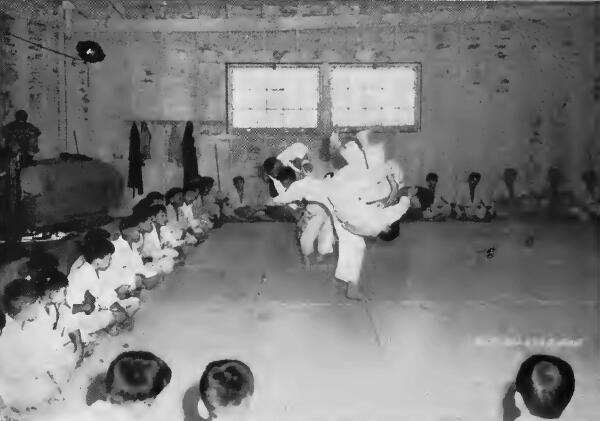 FIGURE 90: A group of young evacuees receiving instruction in Jiu Jitsui, or Judo wrestling, at Portland (Oregon) Assembly Center, while rest of class look on. 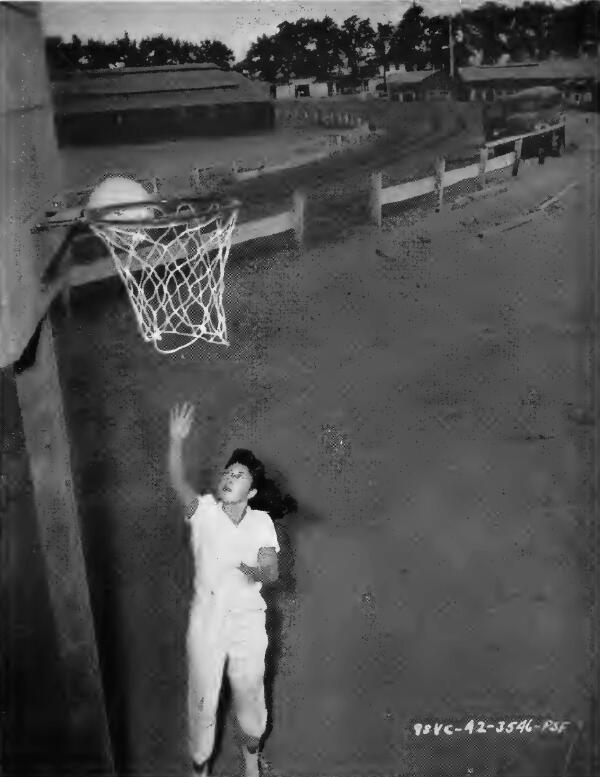 FIGURE 91: A shot at the basket at Stockton (California) Assembly Center. Basketball, Softball and other forms of sports were available to the feminine evacuees. 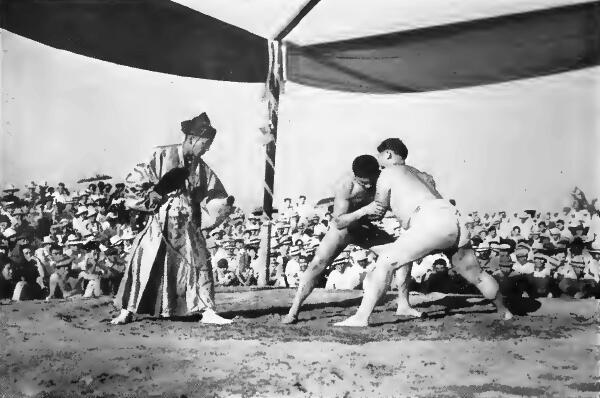 FIGURE 92: A sumo match at Santa Anita (California) Assembly Center, with the referee in traditional costume. Sumo, another form of Japanese type wrestling, was a favorite activity at the Centers. 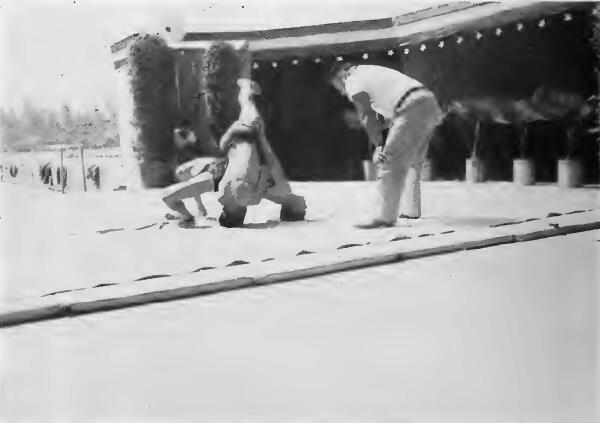 FIGURE 93: Action in an American style wrestling match at Santa Anita (California) Assembly Center. 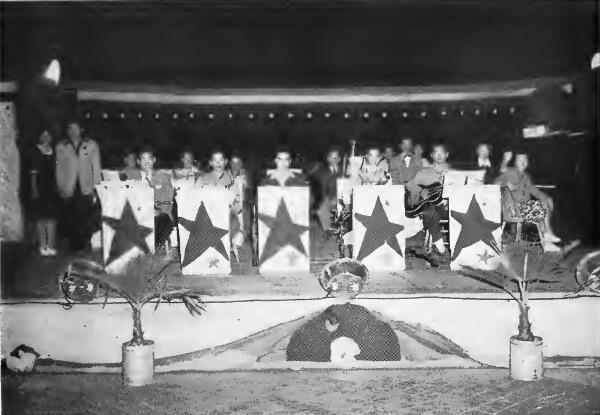 FIGURE 94: The "Starlight Serenaders," a first class dance orchestra organized at Santa Anita (California) Assembly Center. This is one of many dance and concert orchestras organized at the Assembly Centers. 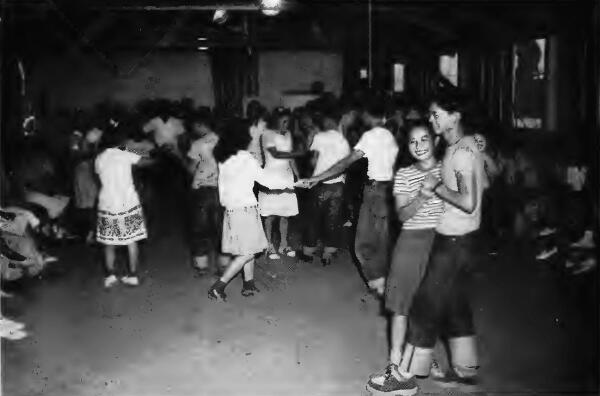 FIGURE 95: A dance scene at Fresno (California) Assembly Center. Dancing was an almost nightly diversion for the younger evacuees at the Centers. 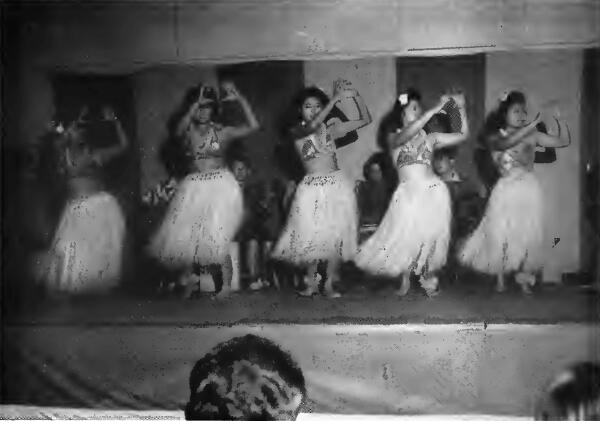 FIGURE 96: Japanese-Hawaiian hula dancers on an improvised stage during one of the frequent talent shows at Santa Anita (California) Assembly Center. 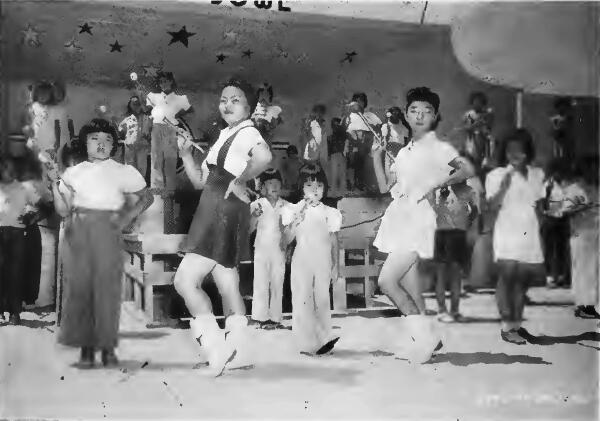 FIGURE 97: Majorettes of all sizes and ages in drills at Fresno (California) Assembly Center. Drill teams of many types were organized at various Centers. 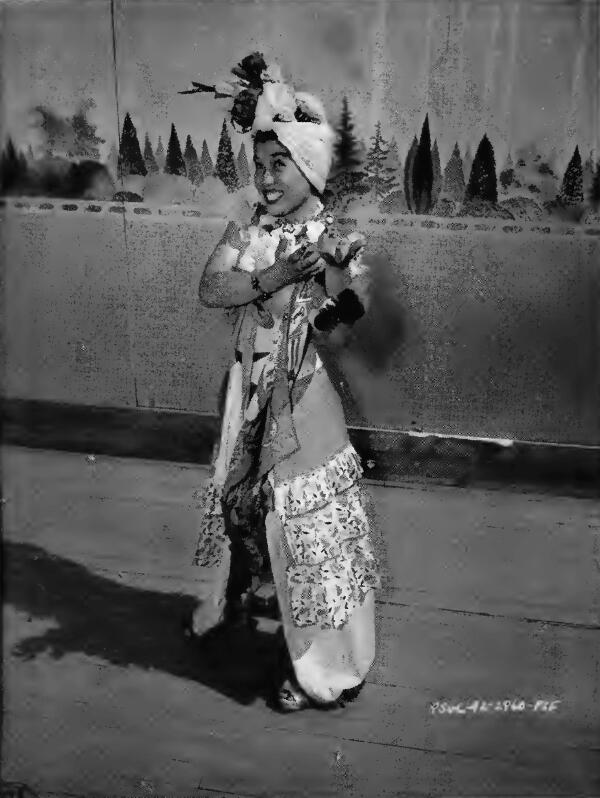 FIGURE 98: A Japanese girl impersonating a popular motion picture actress at Turlock (California) Assembly Center Amateur show. Vaudeville and native Japanese theatricals were staged at various Centers. 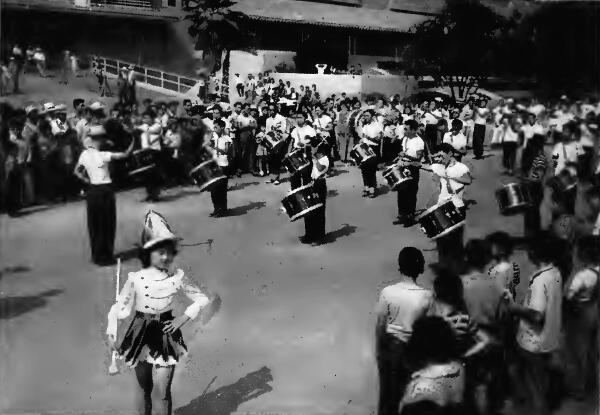 FIGURE 99: A Boy Scout drum and bugle corps at Santa Anita (California) Assembly Center led by Majorette. Scout activities were carried on at virtually all Centers. 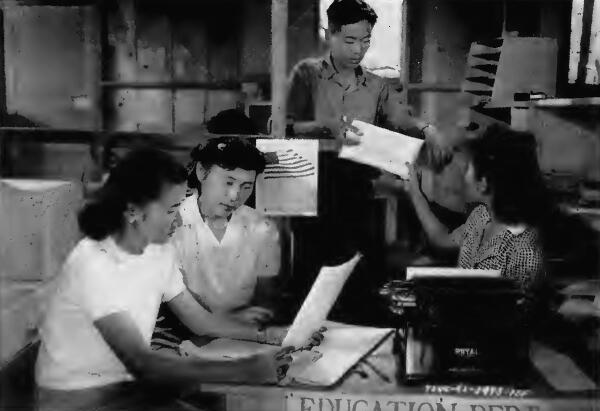 FIGURE 100: The education administrative department at Fresno (California) Assembly Center. Educational departments that supervised work for all ages were established at all Centers, staffed by evacuees under Caucasian supervision. 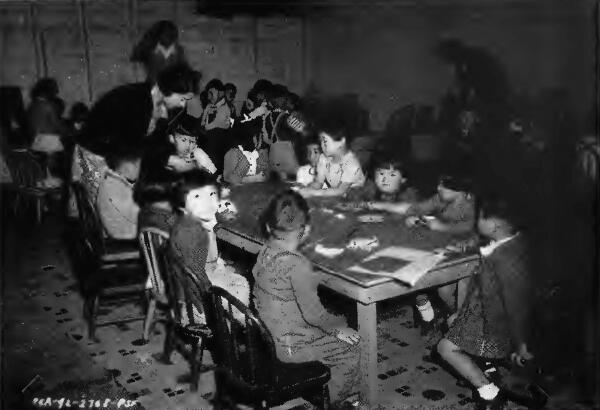 FIGURE 101: The kindergarten room at Portland (Oregon) Assembly Center. Educational programs were developed by the Service Division and classes were organized for all groups from nursery schools to adult education. 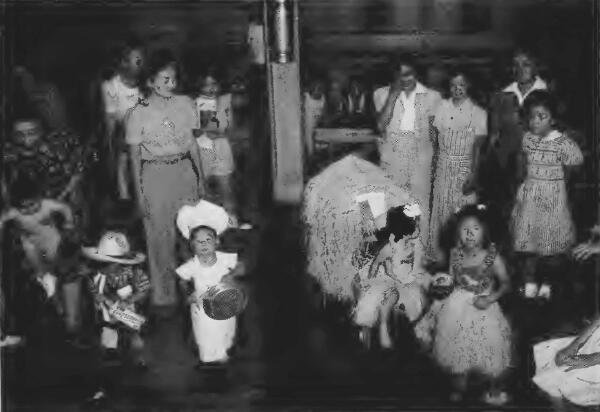 FIGURE 102: Kindergarten children dress in costume to take part in a baby parade and show at Santa Anita (California) Assembly Center. 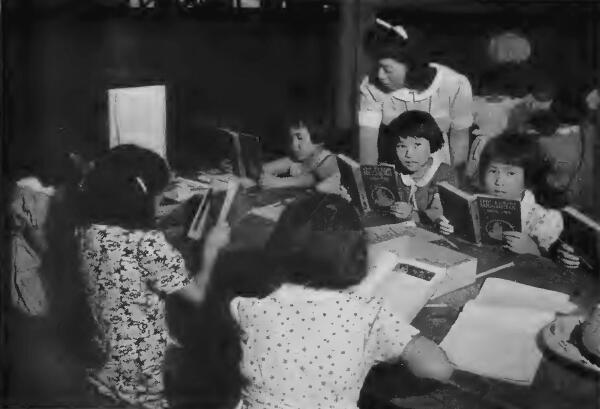 FIGURE 103: An elementary class at Santa Anita (California) Assembly Center. 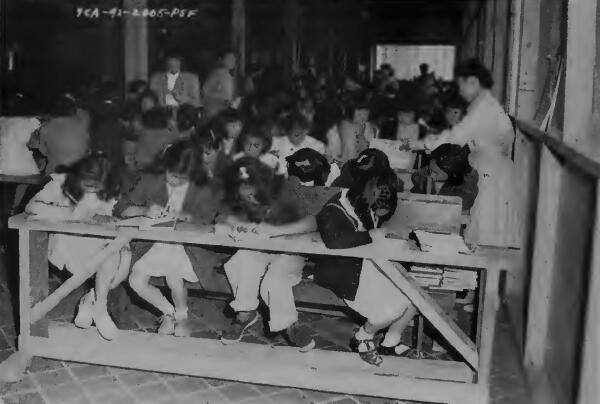 FIGURE 104: A class in the lower grades at Santa Anita (California) Assembly Center. 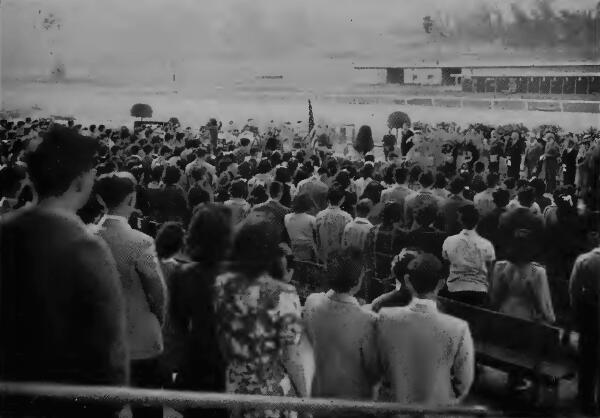 FIGURE 105: At the Santa Anita (California) Assembly Center junior and senior high school students who were unable to graduate with their former home town classes because of evacuation receive diplomas at a special graduating ceremony. 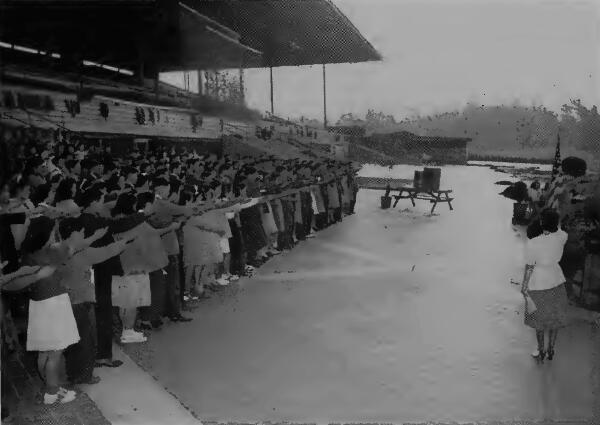 FIGURE 106: Graduating students pledging allegiance to The Flag preliminary to the distribution of diplomas, at the graduation ceremonies at the Santa Anita (California) Assembly Center. 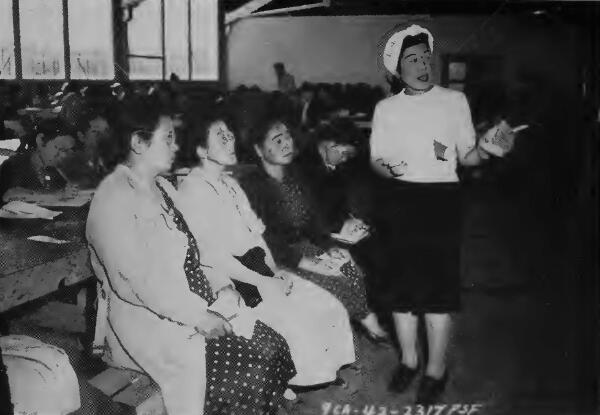 FIGURE 107: A Japanese teacher instructing a group of adult evacuees at Tanforan (California) Assembly Center. Many middle-aged and elderly evacuees, particularly women, took an active interest in adult education. 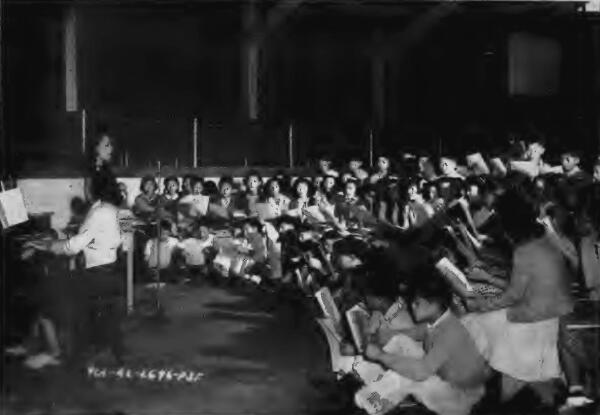 FIGURE 108: Singing classes were organized and conducted at all the Centers by experienced Japanese teachers. A teacher leading a singing class at Portland (Oregon) Assembly Center. 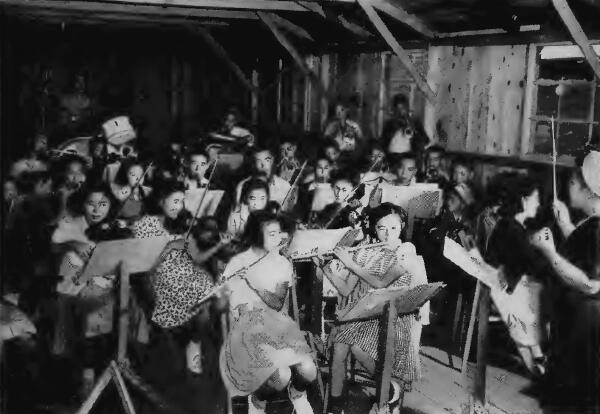 FIGURE 109: A teen-age orchestra tuning up under the leadership of a Japanese woman instructor at Salinas (California) Assembly Center. Orchestras were organized among all age groups at different centers. 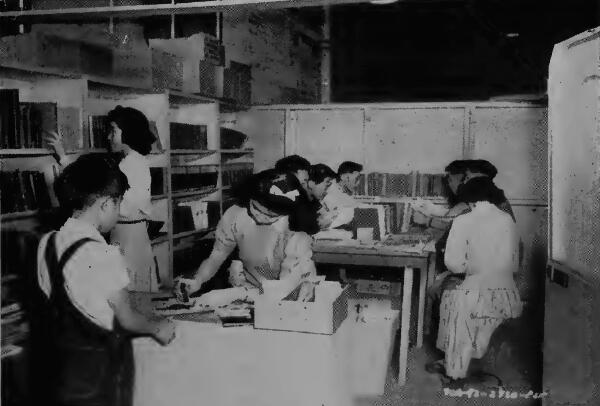 FIGURE 110: Libraries were established at all the Centers, volumes being furnished by state, county and city educational departments, churches, and other organizations, and friends of evacuees. The library at Portland (Oregon) Assembly Center. 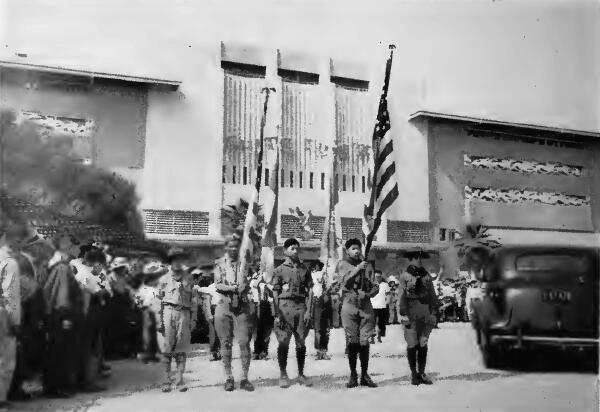 FIGURE 111: A Boy Scout Color Guard leading a parade at a celebration in Santa Anita (California) Assembly Center. 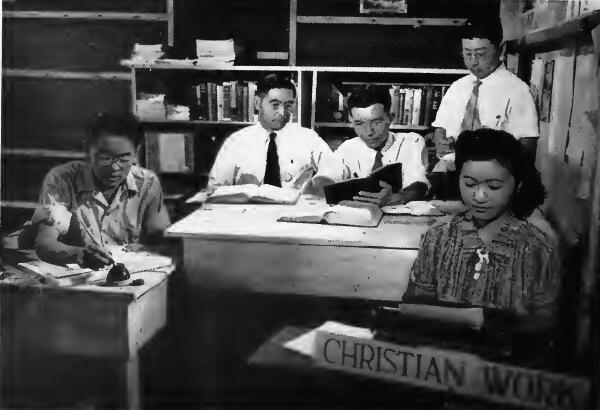 FIGURE 112: A section of the Christian Work study section at Fresno (California) Assembly Center. Evacuees enjoyed freedom of worship at all the Centers. 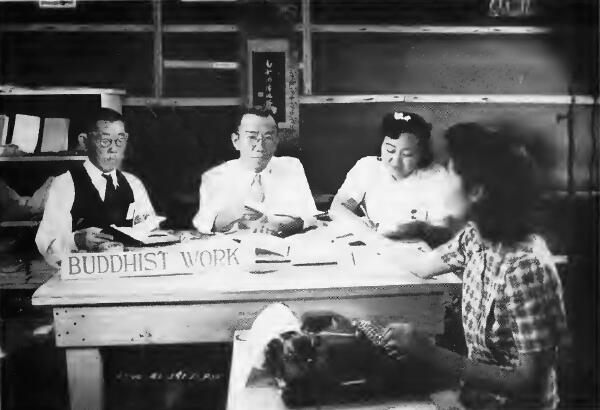 FIGURE 113: A Buddhist group at Fresno (California) Assembly Center. 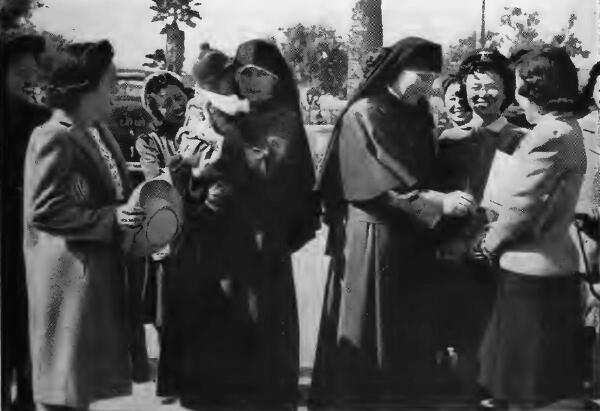 FIGURE 114: Maryknoll Sisters visiting their former wards at Santa Anita (California) Assembly Center. 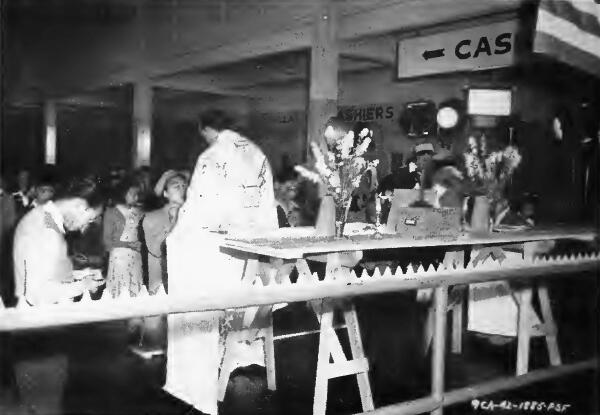 FIGURE 115: Mass was celebrated and other Catholic religious activities carried on at all the Centers. A Catholic Mass at Santa Anita (California) Assembly Center. 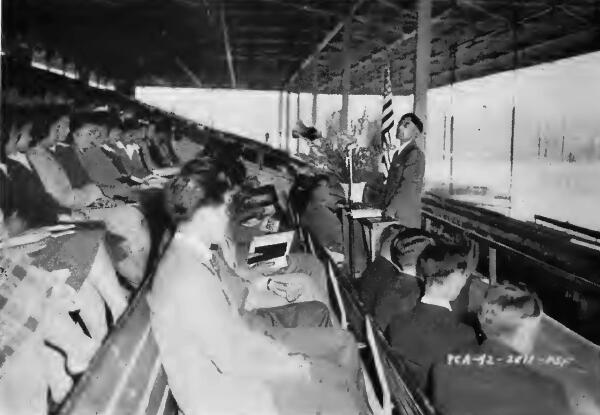 FIGURE 116: A Christian minister conducting services in the grandstand at Santa Anita (California) Assembly Center. 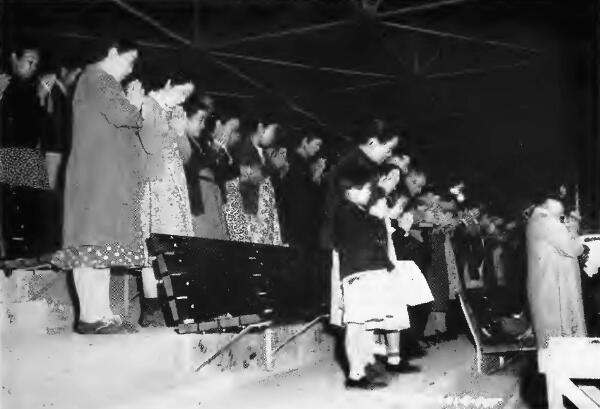 FIGURE 117: A Buddhist congregation praying at Santa Anita (California) Assembly Center. 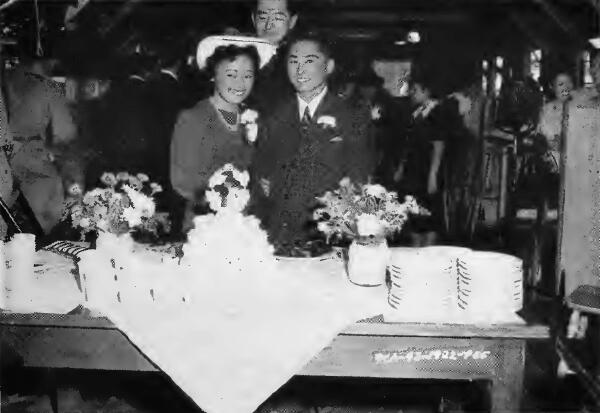 FIGURE 118: A happy young couple immediately after the ceremony at Santa Anita (California) Assembly Center. Numerous weddings of evacuees occurred at the Assembly Centers. 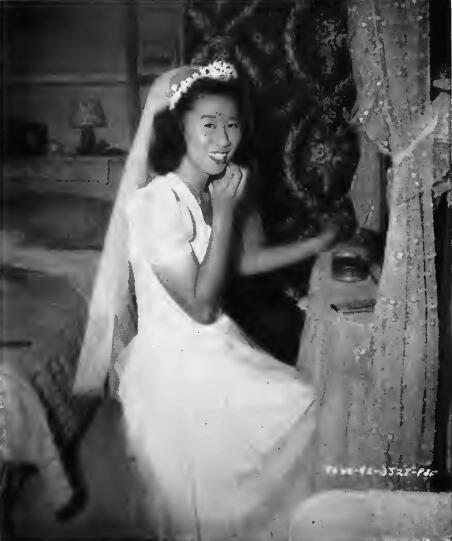 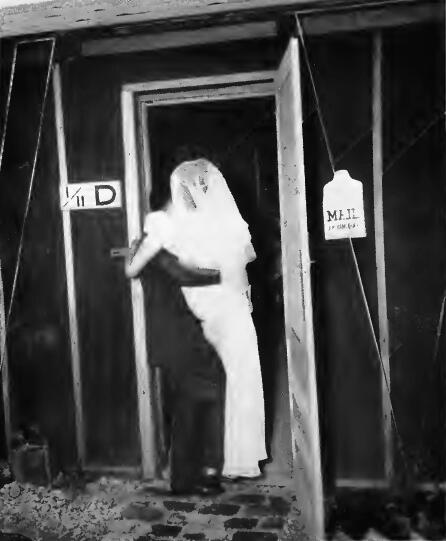 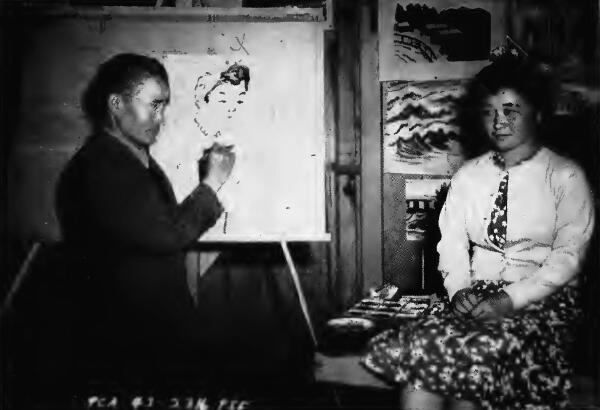 FIGURE 121: A Japanese artist sketching girl posed against a background of landscapes at Tanforan (California) Assembly Center. Art classes for all ages were conducted at various Centers. 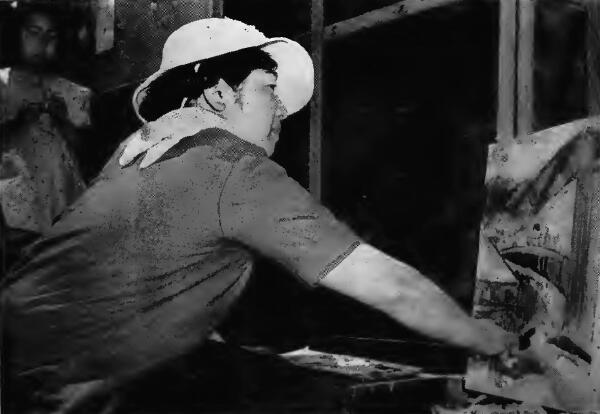 FIGURE 122: A woman artist at work on a landscape scene at Tanforan (California) Assembly Center. 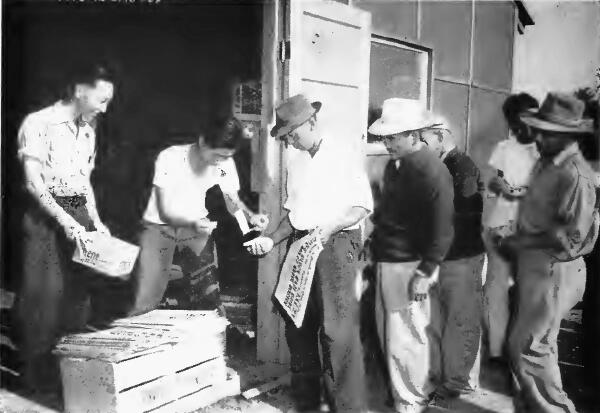 FIGURE 123: Evacuees buying San Francisco morning papers at Turlock (California) Assembly- Center. Newspapers from metropolitan and local communities were available for purchase by the evacuees at all Centers. 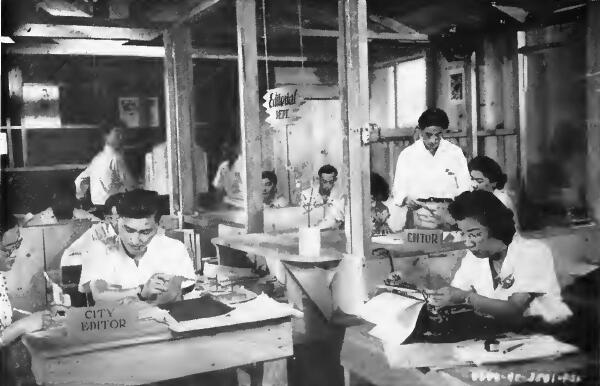 FIGURE 124: The editorial offices of the "Grapevine," the Fresno (California) Assembly Center newspaper. Each of the Centers had its own newspaper, a mimeographed publication with news, editorial, art work and mimeographing done by the evacuees under the supervision of the Center Manager and the Press Relations Representative. 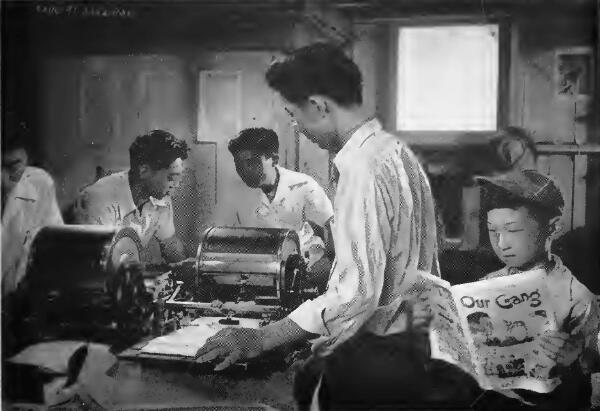 FIGURE 125: The Center newspaper, the "Grapevine," being mimeographed at Fresno (California) Assembly Center. The office boy appears to be more interested in "Our Gang" than in the mimeographing. 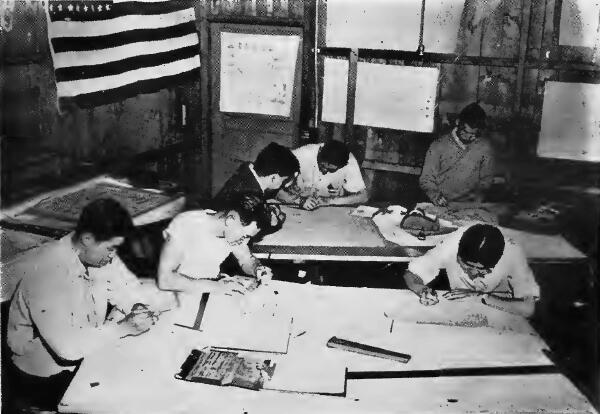 FIGURE 126: A group of evacuees busy in a drafting room of an Assembly Center.  FIGURE 127: Evacuees receiving tools and supplies at the Supply Depot at Portland (Oregon) Assembly Center. Work crews, on a pay basis, took care of the maintenance of the Assembly Centers. 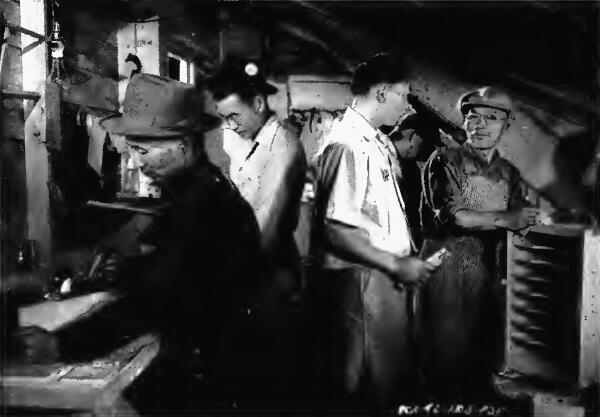 FIGURE 128: The interior of a carpenter shop at Portland (Oregon) Assembly Center. Many of the work projects, in the Centers, called for skilled mechanics. 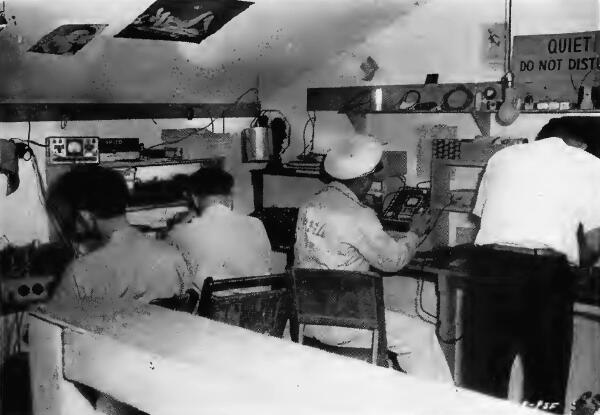 FIGURE 129: A radio shop at Portland (Oregon) Assembly Center where the sets owned by evacuees were repaired. Radio sets, without long or short wave bands, remained in the possession of the Japanese evacuees. 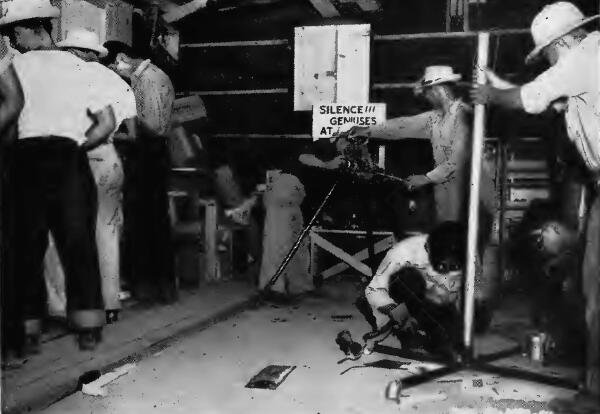 FIGURE 130: Diversified outlets for mechanical skills provided work with pay for many evacuees in the Assembly Centers. A group of mechanics welding an upright in the plumbing shop at Fresno (California) Assembly Center. 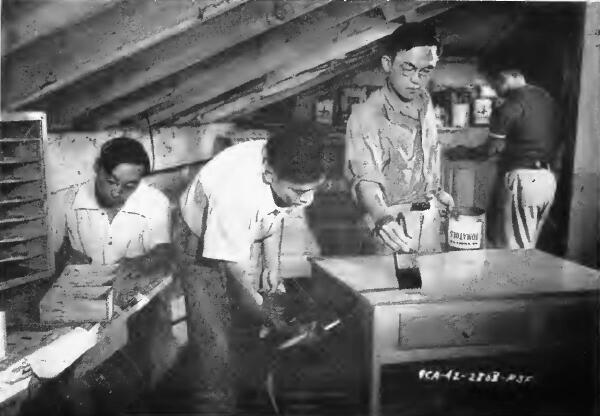 FIGURE 131: A paint shop at Portland (Oregon) Assembly Center with young evacuees finishing an office desk and file box. 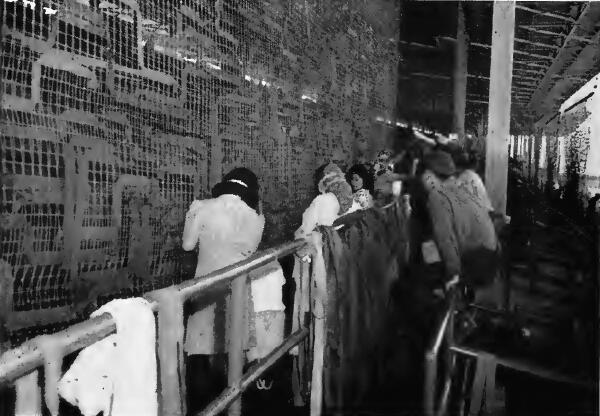 FIGURE 132: Making camouflage nets at Santa Anita (California) Assembly Center. This work is termed "garnishing." A "pattern net" with a design woven into it is first set up and over it a plain net is placed. Weavers worked burlap strips into the top net, following exactly the pattern net as to color and weaving design. The women at work are American-born Japanese. 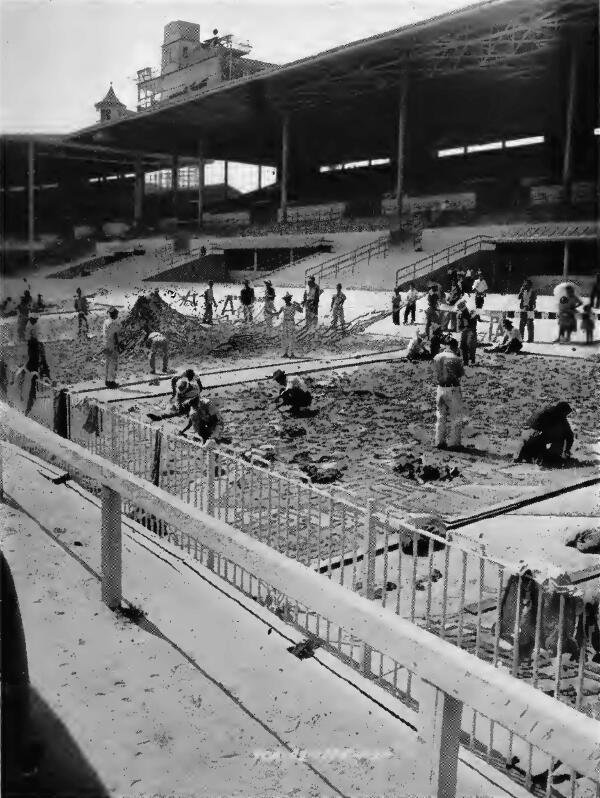 FIGURE 133: Japanese evacuees in a progressing stage of making camouflage nets at Santa Anita (California) Assembly Center. To the left a group raises a partially completed net. 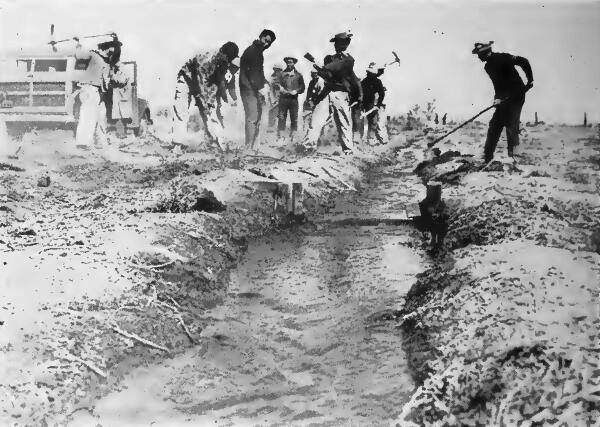 FIGURE 134: Evacuee clearing an irrigation ditch to bring water to the experimental station for the growing of the rubber producing guayule shrub at the Manzanar (California) Reception Center. This was one of the first work projects to be instituted at Manzanar. 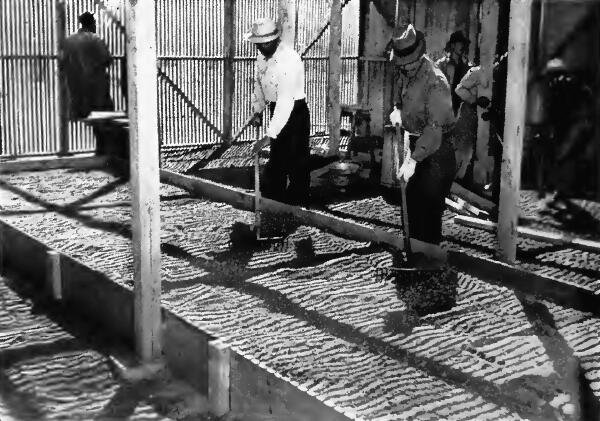 FIGURE 135: Evacuees preparing a seed bed in the experimental station for the growing of the rubber producing guayule shrub, at Manzanar (California) Reception Center. 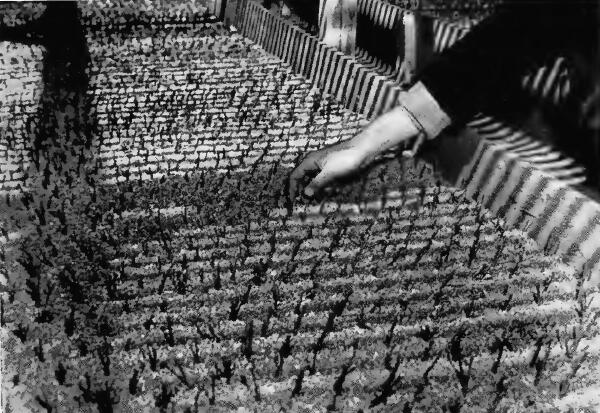 FIGURE 136: Tiny guayule plants being thinned out and replanted for the production of rubber at Manzanar (California) Reception Center by evacuees experienced in agriculture. 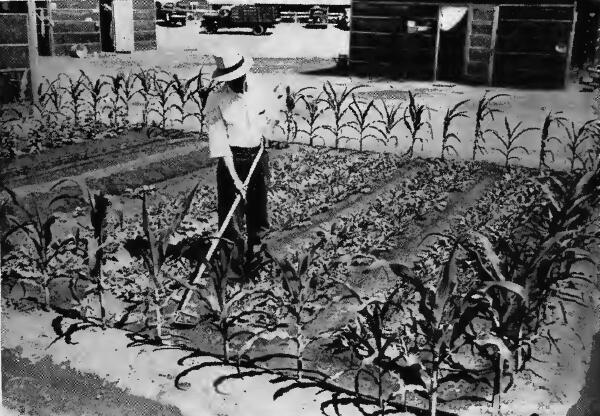 FIGURE 137: A Japanese evacuee hoeing in his garden at Fresno (California) Assembly Center. Many gardens flourished in the Assembly Centers brightening the open spaces between barracks. 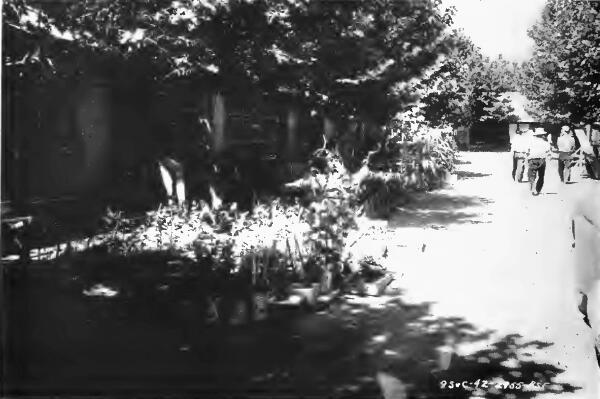 FIGURE 138: A street scene in Turlock (California) Assembly Center with flowering plants massed in front of the barracks. Many of the Japanese, prior to evacuation, had been commercial gardeners and nurserymen, and carried their love of growing things to the Assembly Centers. 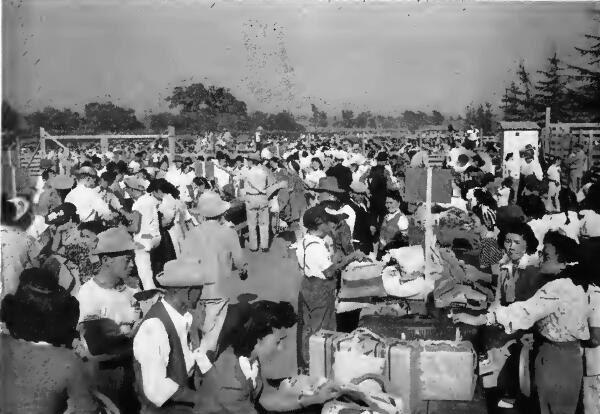 FIGURE 139: Family groups identifying their hand baggage prior to departure from the Assembly Center at Santa Anita, California for a Relocation Center, operated by the War Relocation Authority, a civilian agency. The transfer of the evacuees from the Assembly Centers to War Relocation Centers was conducted by the Army. 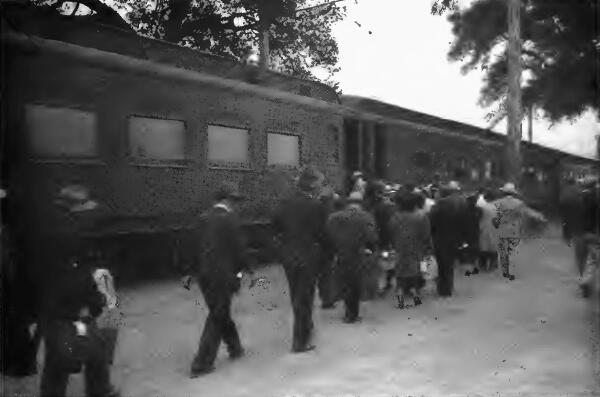 FIGURE 140: Evacuees boarding a special train at Santa Anita (California) Assembly Center enroute to a War Relocation Center. Great care was exercised for the comfort of the evacuees traveling from Assembly Centers to War Relocation Centers. Each train carried a Caucasian physician and two nurses. Pullman cars, as needed, were furnished with each train to provide special accommodations for the aged, the infirm and mothers with infants. 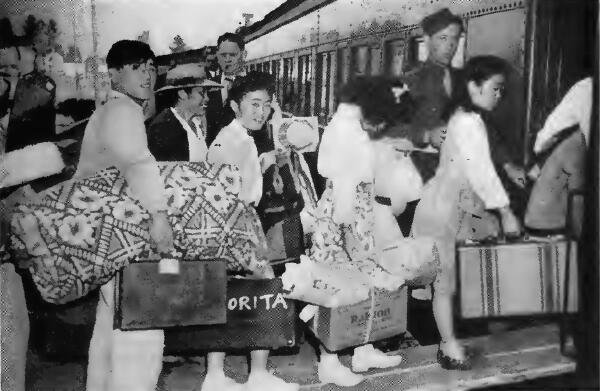 FIGURE 141: A group boarding the train at Portland (Oregon) Assembly Center which will take them to a War Relocation Center for evacuees. 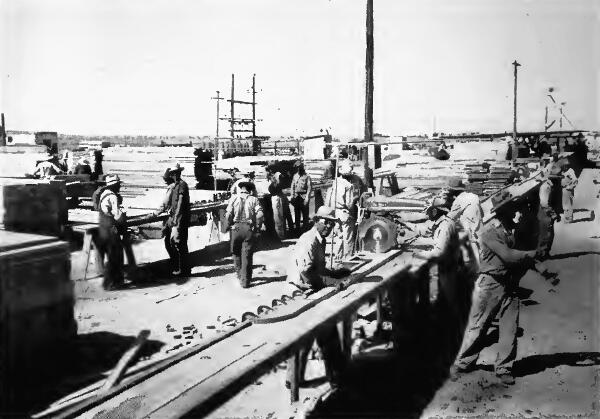 FIGURE 142: While the evacuation program was under way placing persons of Japanese ancestry in Assembly Centers, construction of War Relocation Centers was begun by Army Engineers. Construction operations at Heart Mountain Relocation Center, near Cody, Wyoming. 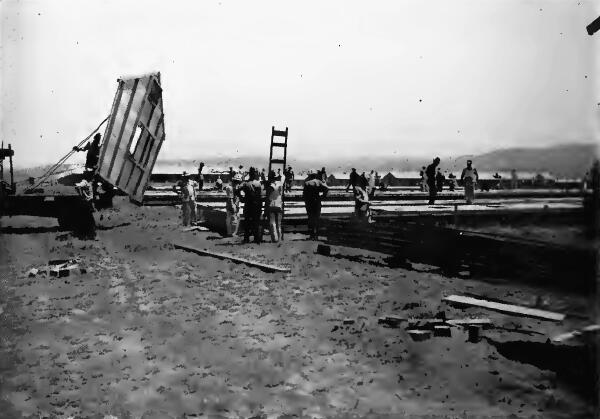 FIGURE 143: Buildings were put together in sections in a central construction area and these sections hauled by truck to the building site. 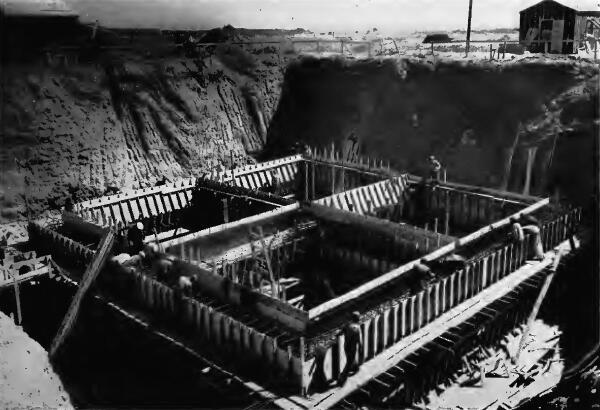 FIGURE 144: Deep below the sod of Heart Mountain Relocation Center, near Cody, Wyoming, once pounded by buffalo herds, rise the forms of reinforced concrete to house Imhoff or sanitary tank. 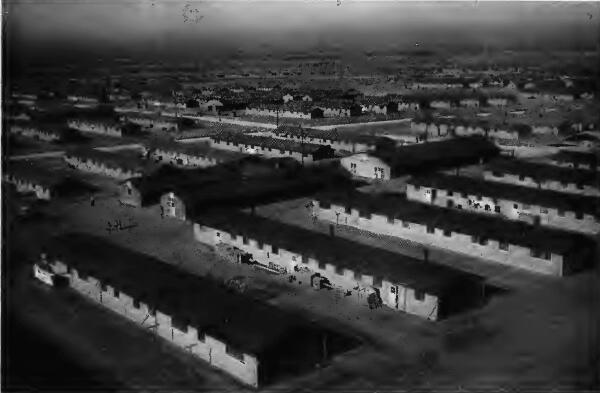 FIGURE 145: Panorama of Granada Relocation Center, Amache, Colorado, showing in the foreground a typical barracks unit consisting of 12 six-room apartment barracks buildings, a recreation hall, laundry and bathhouse, and the mess hall, constructed by Army Engineers. The Center is made up of 30 such blocks, complemented by hospital buildings, administrative office buildings, living quarters, general warehouse structures and Military Police quarters. 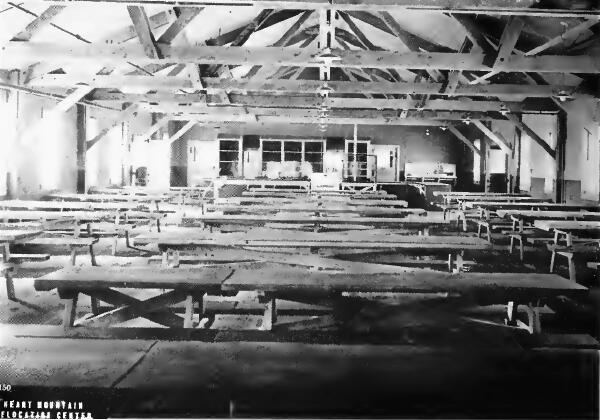 FIGURE 146: Typical mess hall in a Relocation Center hospital unit is completed by Army Engineers. 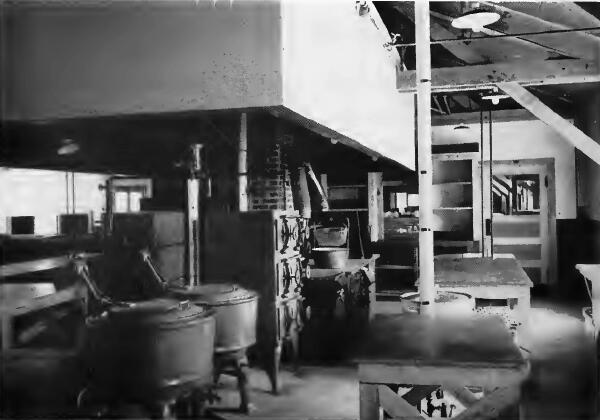 FIGURE 147: Ready to begin service this modern, well-equipped kitchen is attached to the hospital unit at Heart Mountain Relocation Center. 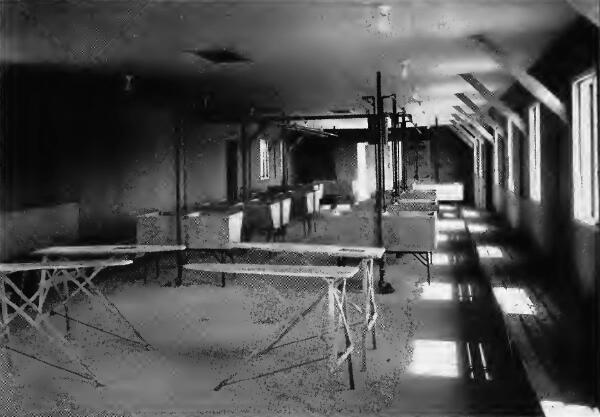 FIGURE 148: Airy and spotless is this section of a Relocation Center laundry with modern plumbing and tanks, ironing boards and side-wall bench for bundles. 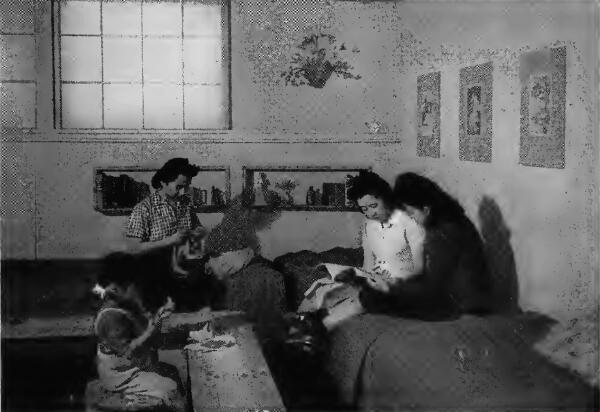 FIGURE 149: Typical evacuee apartment at Granada Relocation Center, Amache, Colorado. The furniture, the book niches, flower pots and print mats are all made by the evacuees from scrap lumber and scrap pieces of wall board. |